How to identify British trees – by leaf, fruit, shape, size, bark and more
Once you can separate the ‘wood from the trees’, identifying trees can become a real joy, giving a totally different take on a walk in the park

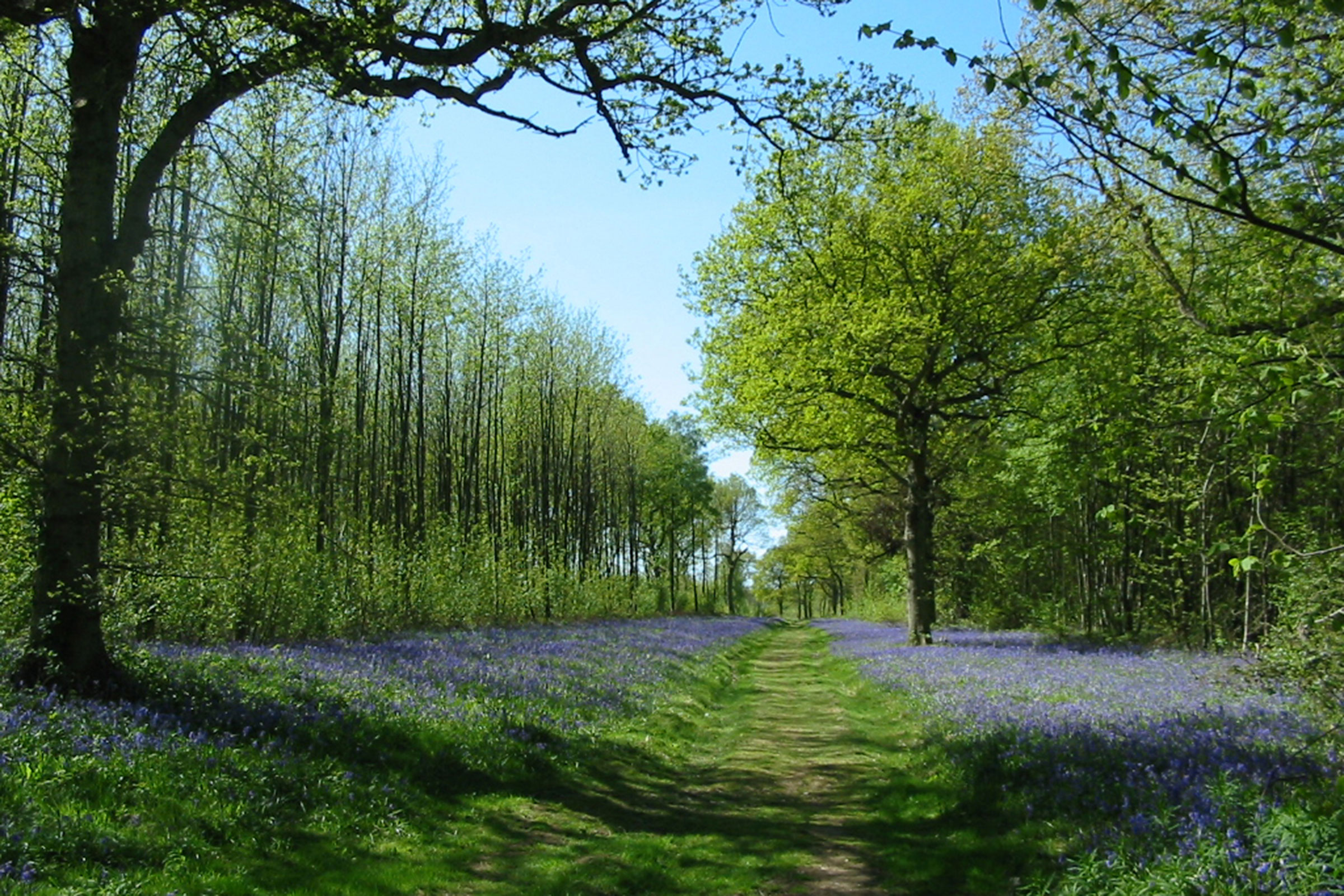
Once you can sort the ‘wood from the trees’ and get a clear idea of what to look for identifying trees can become a real joy, giving a totally different take on a walk in the park or local forest.
We've been working with Tony Russell, author of The World Encyclopedia of Trees, to ascertain what features make each tree stand apart, to make the job of distinguishing them that much easier.
To start, we've identified what to look for – the seven main features and the questions to ask yourself. Work through these features step by step, and they will lead you to identify a particular tree.
The World Encyclopedia of Trees, £20, is published by Lorenz Books (ISBN 9780754834755)
Start with shape and size
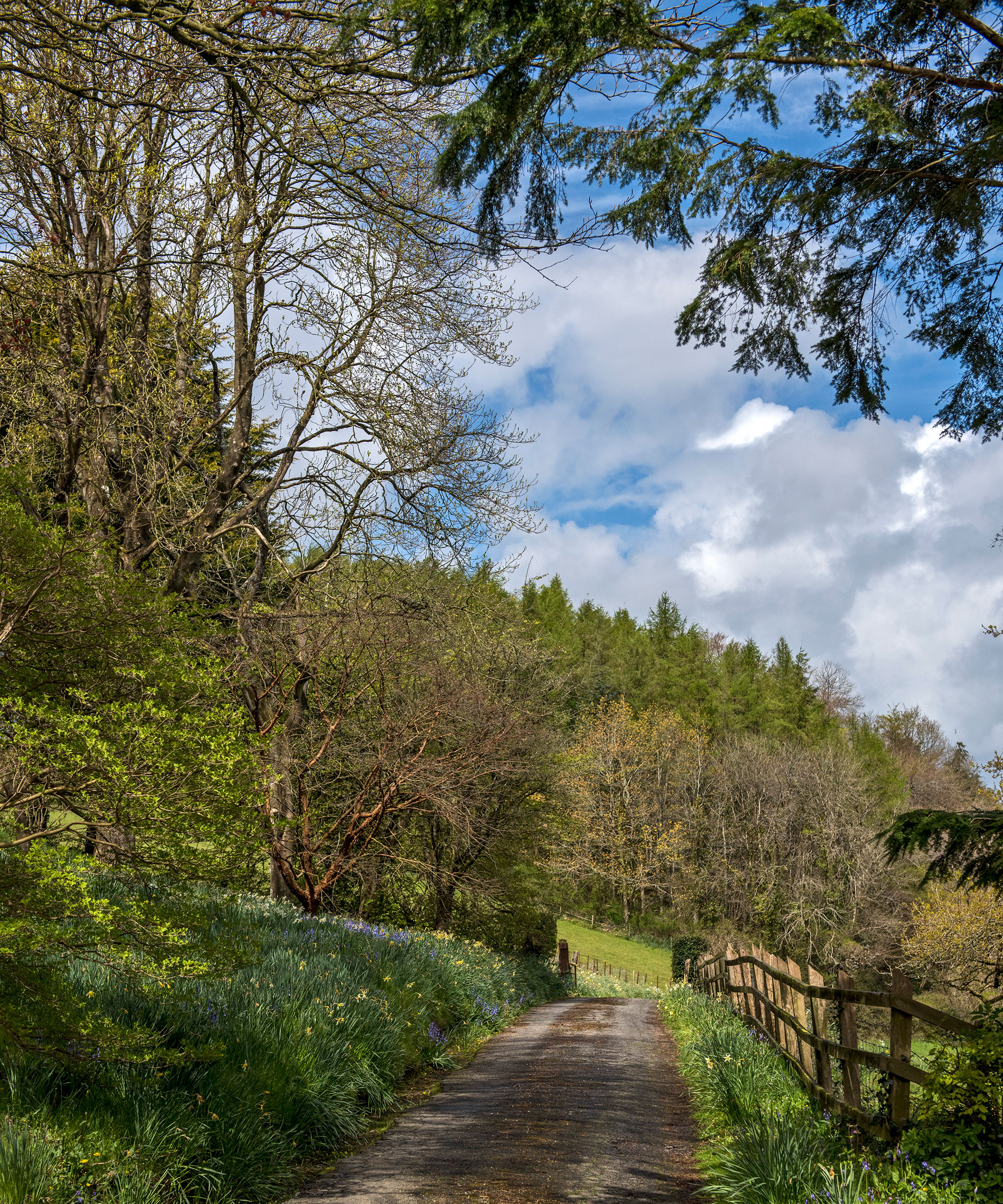
Consider if the tree is tall and spire-like or low and wide spreading.
Some trees have such a distinctive shapes it is quite often possible for it to be identified from a distance based just on its overall shape. For example the monkey puzzle, Araucaria araucana, no other tree has such sharply toothed evergreen foliage and stiff branching – so it is certainly easy to spot from afar.
‘Once a tree has been identified, stand well back from it and try to commit its overall shape to memory. Then look for other trees with similar shape and confirm their identity. After a while you will find that certain species become instantly recognizable.’ says Tony Russell author of The World Encyclopedia of Trees.
Design expertise in your inbox – from inspiring decorating ideas and beautiful celebrity homes to practical gardening advice and shopping round-ups.
Is the tree evergreen or deciduous?
Are there leaves all year round (evergreen) or does the tree lose it’s leaves in autumn (deciduous)?
Most evergreen leaves fall into two categories. They will either be long, thin and needle-like, which will suggest that they belong to a conifer, or they will be thick and leathery, quite often with a shiny surface. A non-conifer evergreen in Britain is quite likely to be either holly, Ilex aquifolium, or holm oak, Quercus ilex, for example.
Look at the leaves
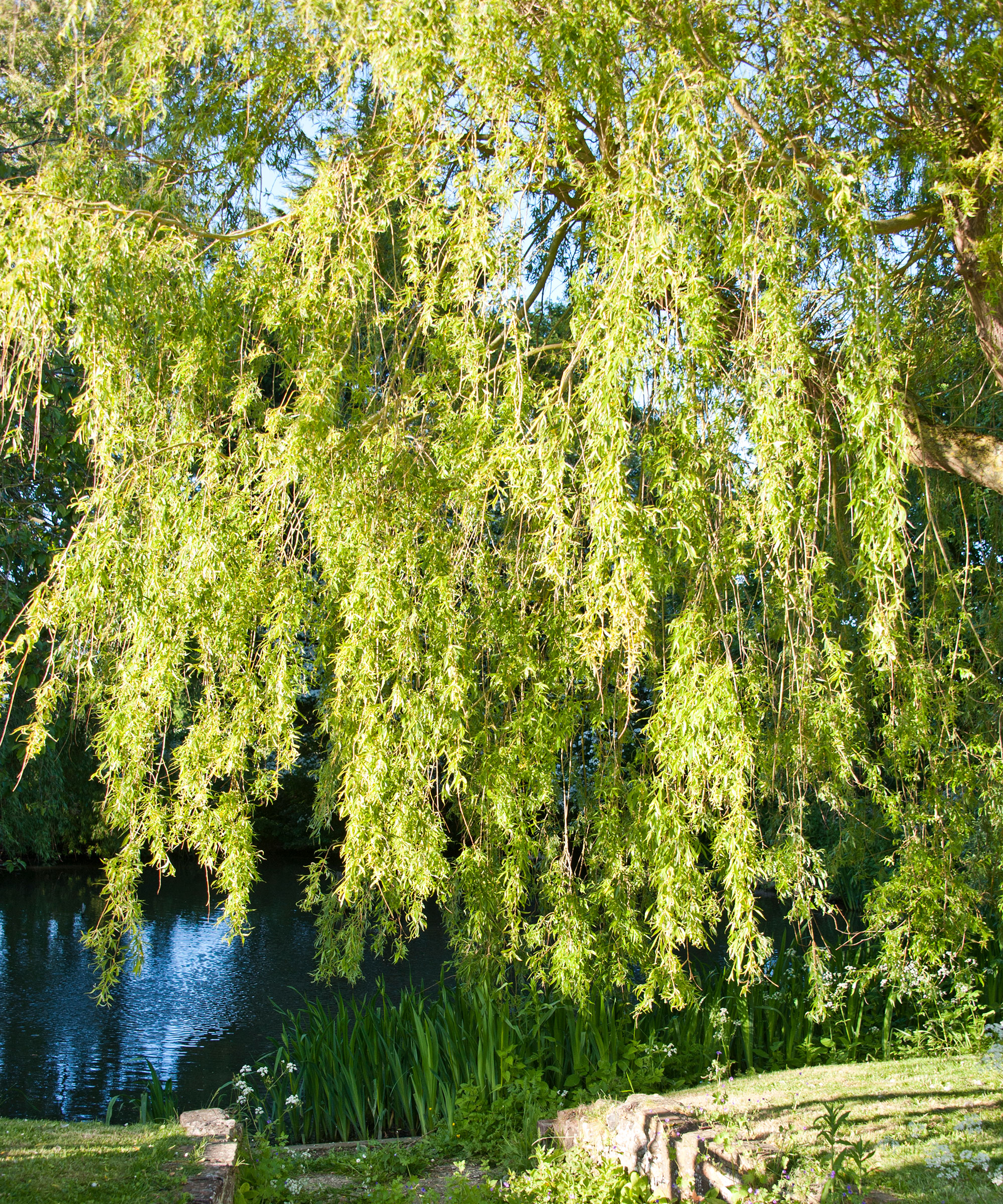
Are they long and needle-like or broad and flat?
There are hundreds of different leaf shapes, colours and arrangements to help identify trees. Needles too are quite distinct, and like leaves, are arranged differently on different trees.
‘For most trees, the leaves are probably the most important aid to identification,' Tony explains. 'There are many different leaf shapes but almost all of them fall into the following six categories.'
'Leaves may be “entire”, which means that they are undivided and have no serrations around the edge, such as those of magnolia.'
'They may be “serrated” with sharp serrations around the edge, as with the leaves of sweet chestnut, or be “lobed”, curving in toward the centre of the leaf and then back out again, as in oak.'
'They may be “palmate”, which means hand or palm-like – maple leaves are palmate.'
'On some leaves the indentations may go right down to the petiole (leaf-stalk) as with horse chestnut, then the leaf is called a “compound palmate” leaf. Sometimes the leaf is subdivided into smaller leaflets, the leaf is then called “pinnate”.’
Focus on flowers and fruit

Are flowers (or flower buds) present? If so what colour and shape are they?
Tree identification can be much easier when flowers are evident. Knowing whether a tree produces flowers in early or late spring, for example, can also help to identify it.
Does the tree have any fruit, berries seeds, nuts or cones on it and if so what are they like?
Late summer to autumn is the best time to identify trees by their fruit. Some fruit or seeds are instantly recognizable – acorns will immediately identify an oak tree and conkers a horse chestnut tree.
Study the bark

Does the bark have distinctive colouring or patterning?
Some trees are probably better known by their bark than any other feature. Silver birch, for example, has striking silvery white bark, while the Tibetan cherry, Prunus serrula, has bark that is polished, peeling and mahogany red.
Pay attention to buds
In winter, buds can be a tremendous help in identifying temperate trees. What colour and shape they are and how they are positioned on the twig.
Winter is the time when tree identification can be most difficult. However, close inspection of the buds can be of considerable help. Ash has very distinctive black buds, for example, while those of magnolias tend to be large and covered with a dense coating of light-grey hairs.
The positioning of buds can also help identify a tree. They may be in pairs on opposite sides of the twig, or they may be alternately positioned with one on the left followed by one on the right. Some buds hug the twig, such as those of willow, while others, such as oak buds, appear in clusters.
Have the right kit to hand
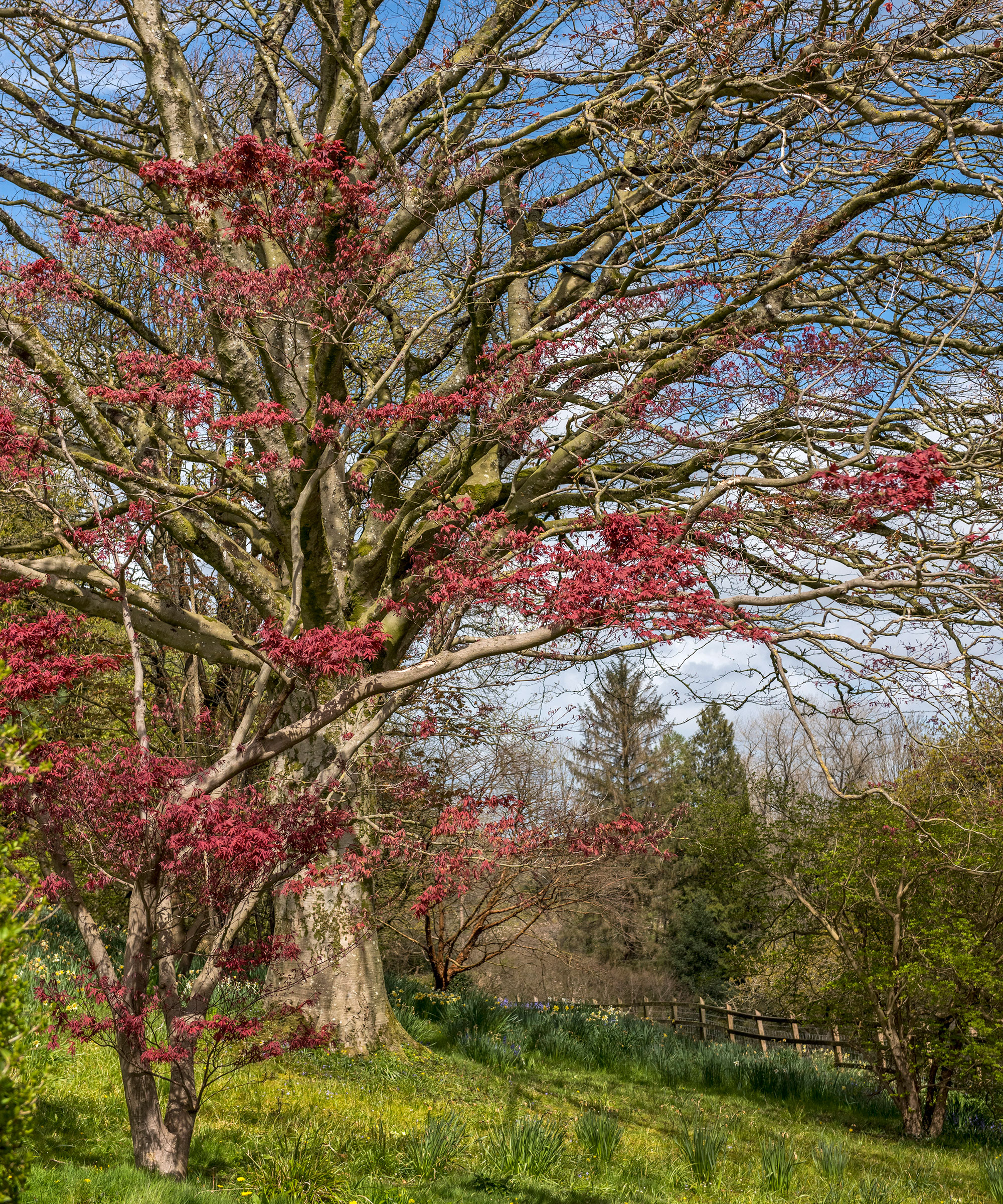
For further reading to brush up your skills before you set out we recommend The World Encyclopedia of Trees by Tony Russell, £20, published by Lorenz Books (ISBN 9780754834755)
This beautifully illustrated volume is the ultimate reference guide to more than 1300 of the most spectacular, best-loved and unusual trees across the globe.
A good field guide that fits inside your pocket is essential and preferably one, which has a waterproof cover too.
Try Concise Tree Guide by The Wildlife Trust, £5.54, Amazon
Also invest in a pair of good binoculars. These can be useful to look at leaves, flowers or buds, which may be at the top of the tree. A notepad and pencil will allow you to sketch relevant features and make notes on locations.
Finally, sealable plastic bags are useful to collect specimen leaves, fruit or seeds to take home for closer examination.
1. Common Ash

Common Ash Fraxinus excelsior has a light airy crown, with a trunk that tends to be straight and long with little branching. The bark is pale fawn when young, becoming grey and fissured with age.
The leaves are pinnate and up to 30cm long. Each may have up to 12 pairs of shallow toothed, rich green leaflets. The leaves can move in the direction of sunlight, and sometimes the whole crown of the tree may lean in the direction of the sun. Another characteristic of ash leaves is that they fall when they are still green.

One distinguishing feature of ash is its velvet-black winter buds. The fruits are flattened, winged seeds known as “keys”, 4cm long, are borne in clusters throughout the winter.
Folklore fact: It was thought that Ash leaves placed beneath the pillow of sleeping unmarried girls would offer them a glimpse in a dream of their future husband.
Photography / The Woodland Trust
2. Rowan
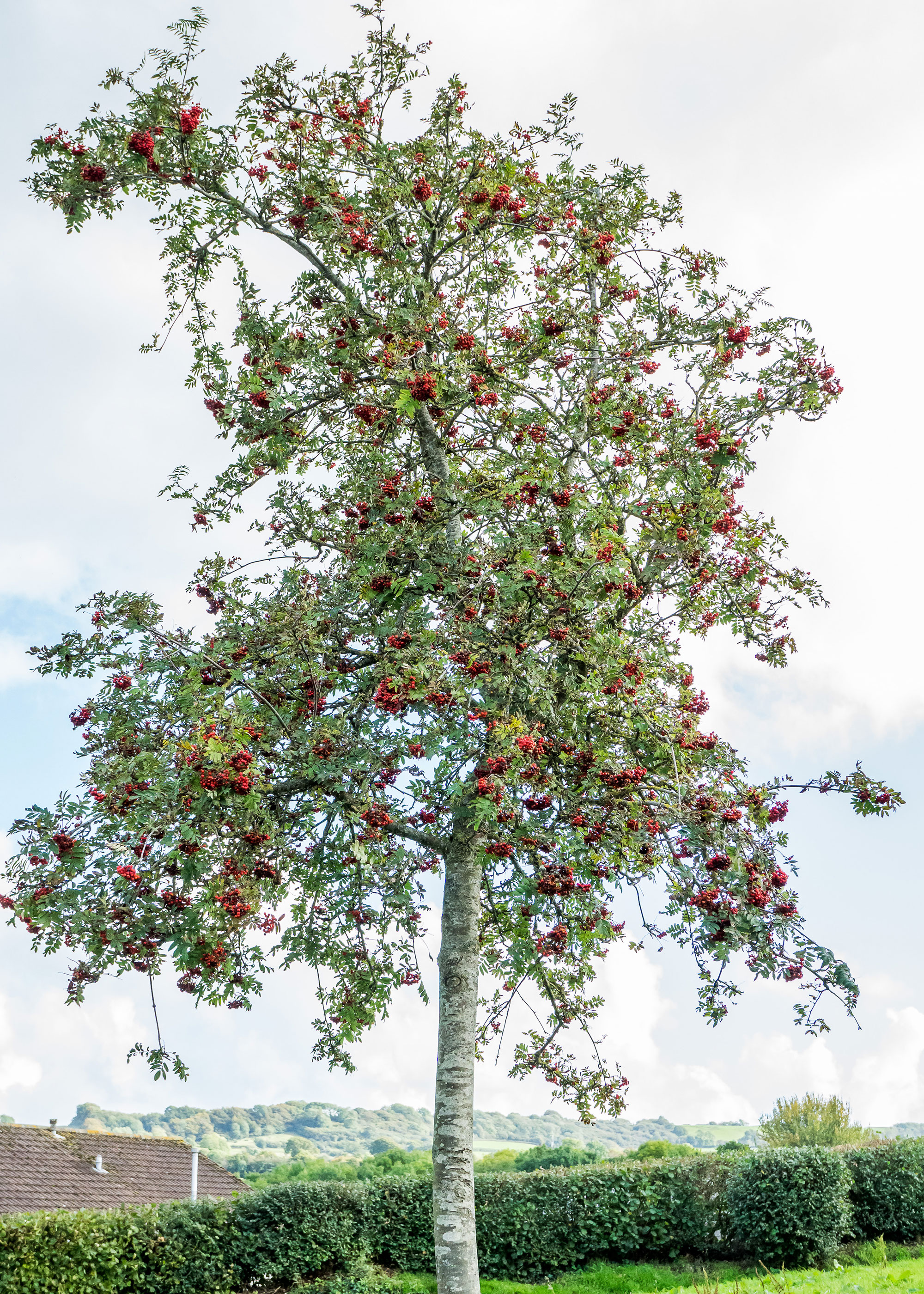
Rowan Mountain ash Sorbus aucuparia is an elegant tree with a mystical history. The bark varies from silver-grey to purple-grey. It is smooth even in maturity.
The pinnate leaves, to 20cm long, comprise up to 15 leaflets, each 5cm long, sharply toothed around the margin, bright green above and blue-green beneath. In autumn, they may turn red or yellow before falling. The creamy-white, fragrant flowers, which appear in late spring, bloom in soft clusters, up to 15cm across.
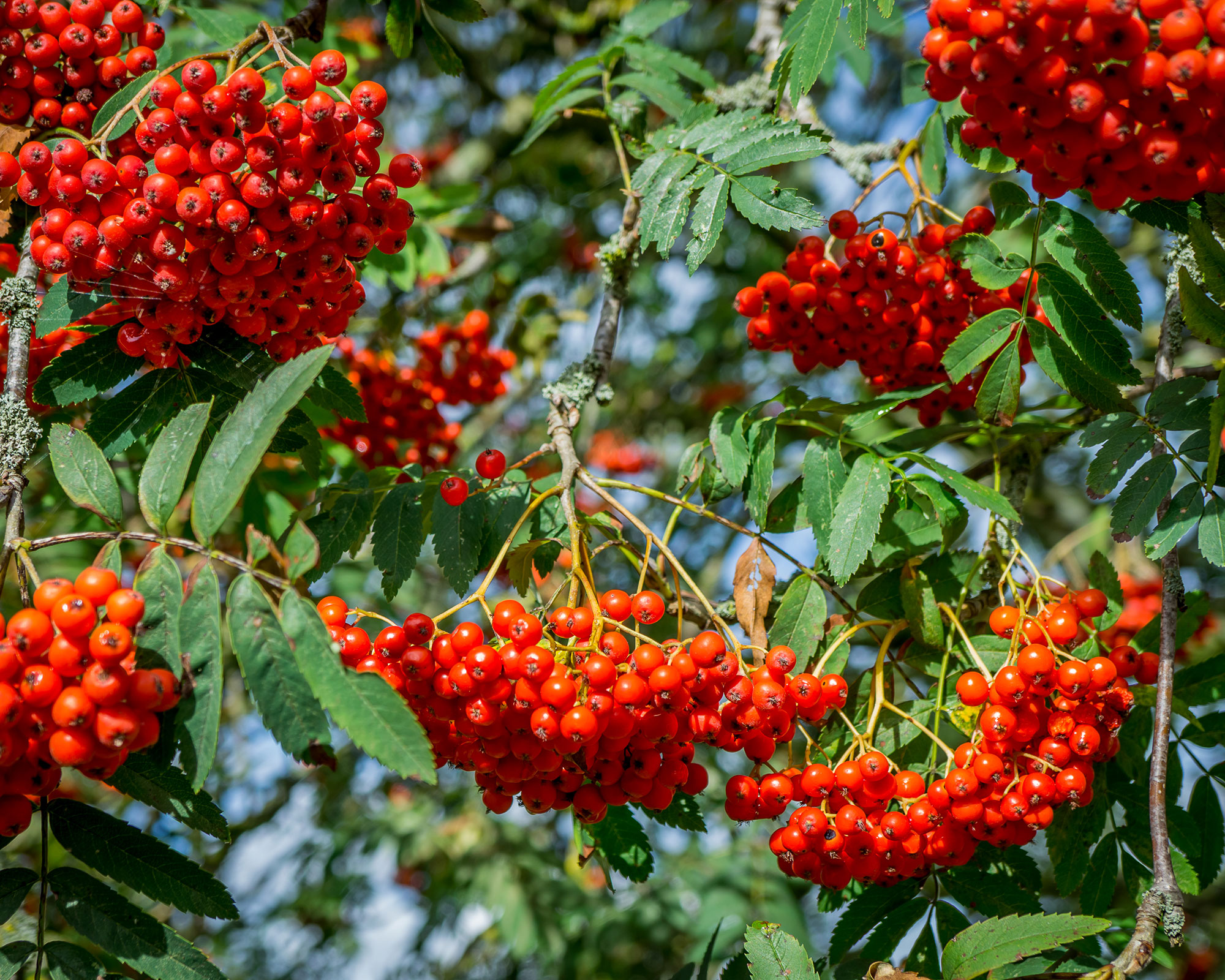
After successful pollination by insects, the flowers develop into scarlet berries, which are 1cm across, borne in large, pendulous clusters.
Folklore fact: It was widely believed that the rowan has protective powers, particularly against witchcraft.
Photography / The Woodland Trust
3. Monkey Puzzle tree
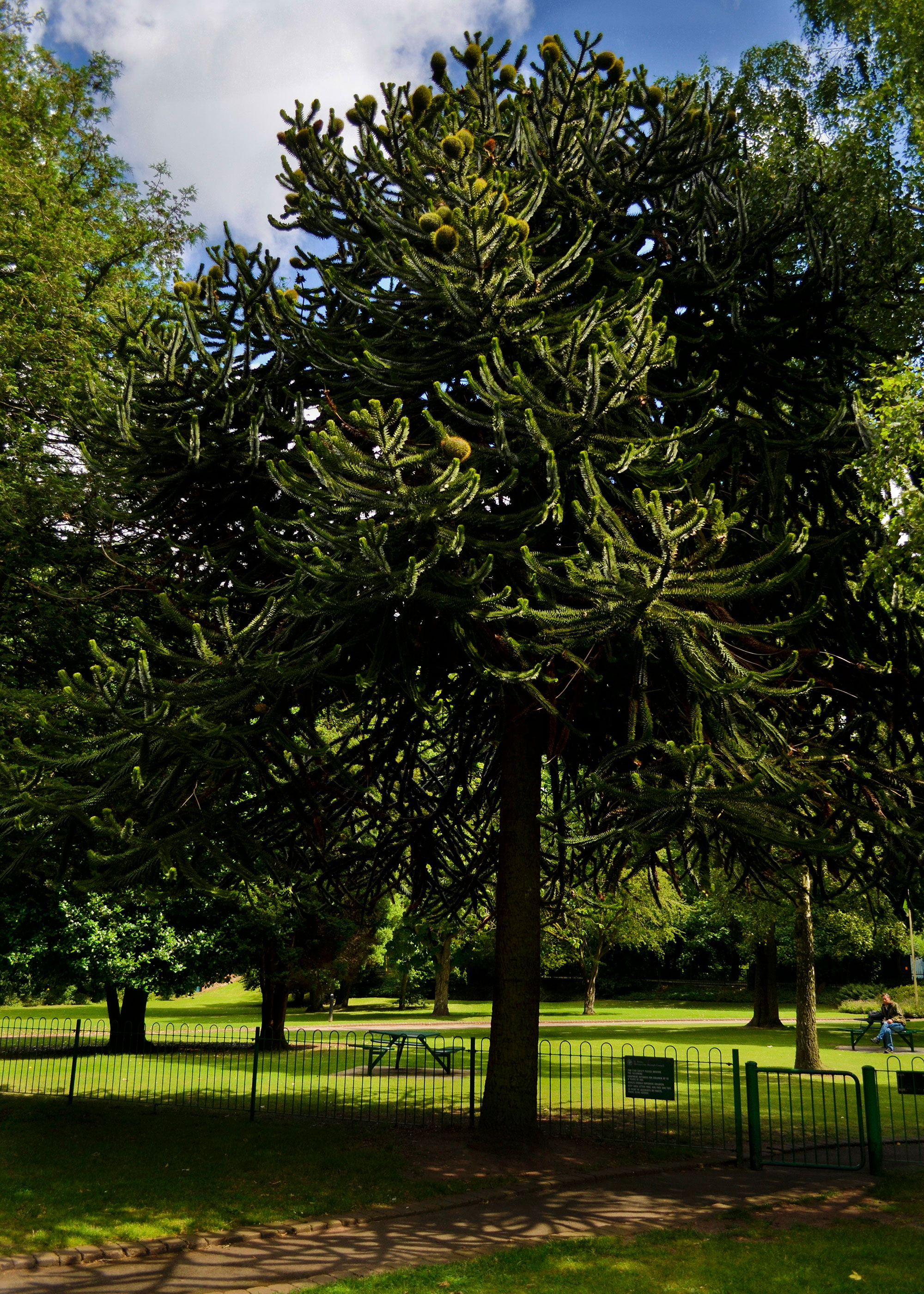
Monkey Puzzle Chile pine Araucaria araucana is uniquely bizarre for its triangular, very sharp, pointed leaves and distinctive whorls of long branches. When young, the tree has a slightly rounded conical outline, with foliage to ground level.
As it matures, the crown broadens and the lower branches fall away. This reveals an impressive trunk with horizontal folds of grey bark, similar in appearance to elephant hide.
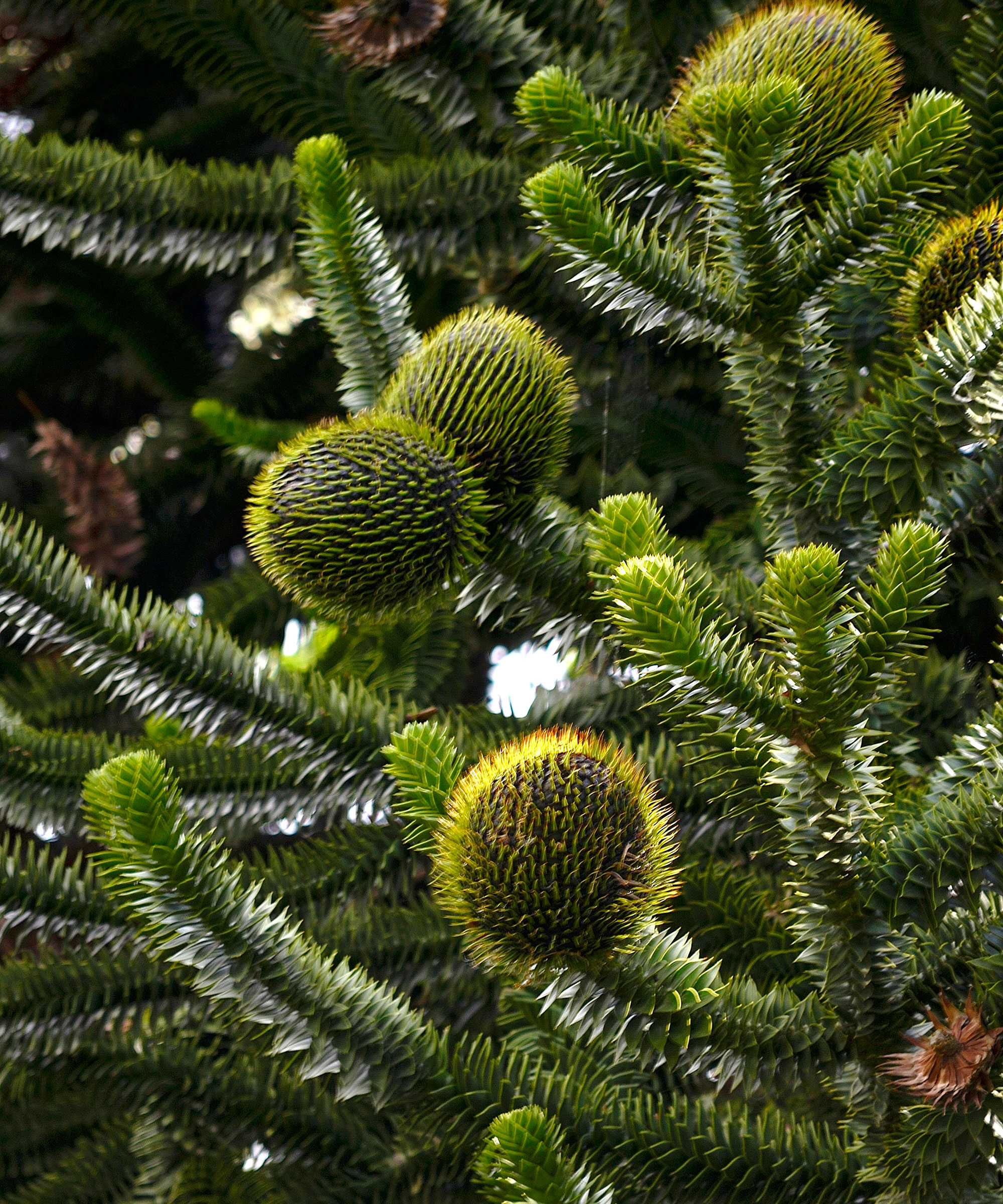
Monkey Puzzles are dioecious, meaning male and female flowers grow on separate trees. The ovoid female cone (shown above) contains up to 200 seeds, the male cones are borne in clusters at the tips of shoots.
Photography / The Woodland Trust
4. English Oak

English Oak Common oak Quercus robur the ruling majesty of the woods is a long-lived tree, with many recorded veterans over 1,000 years old. The bark is pale grey and smooth when young, quickly developing regular vertical fissures.
The leaves, up to 10cm long and 8cm wide, either have no stalk or are on short stalks. The leaf margin is divided into three to six rounded lobes on each side, tapering towards the base where there are normally two smaller lobes. The upper surface is dark green, the underside glaucous.
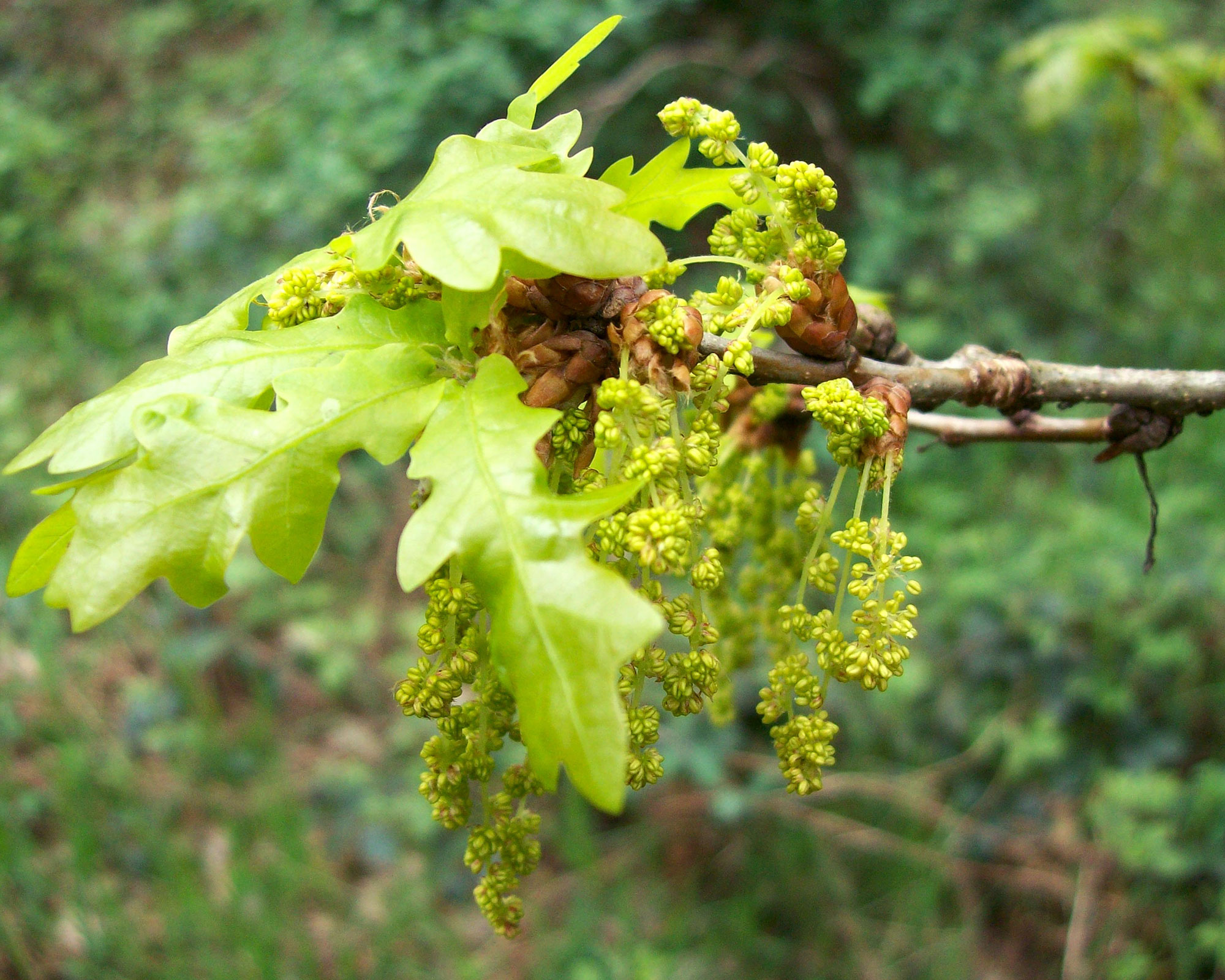
The fruit is an acorn, up to 4cm long, one- third of which is in a cup that is attached to the shoot by a long, slender stalk up to 10cm long. As it ripens, the green acorn turns brown, loosens from the cupule and falls to the canopy below, sprouting the following spring.
The male flowers are long catkins which appear in late spring.
Photography / The Woodland Trust
5. White Willow
White willow, Salix alba the classic weeping willow, thrives in damp soils and grows naturally alongside rivers and in watermeadows.
The dense coating of hairs on the leaves gives the tree an attractive silvery appearance, particularly when the leaves are stirred by the wind. The bark is brown-grey, becoming deeply fissured in maturity.
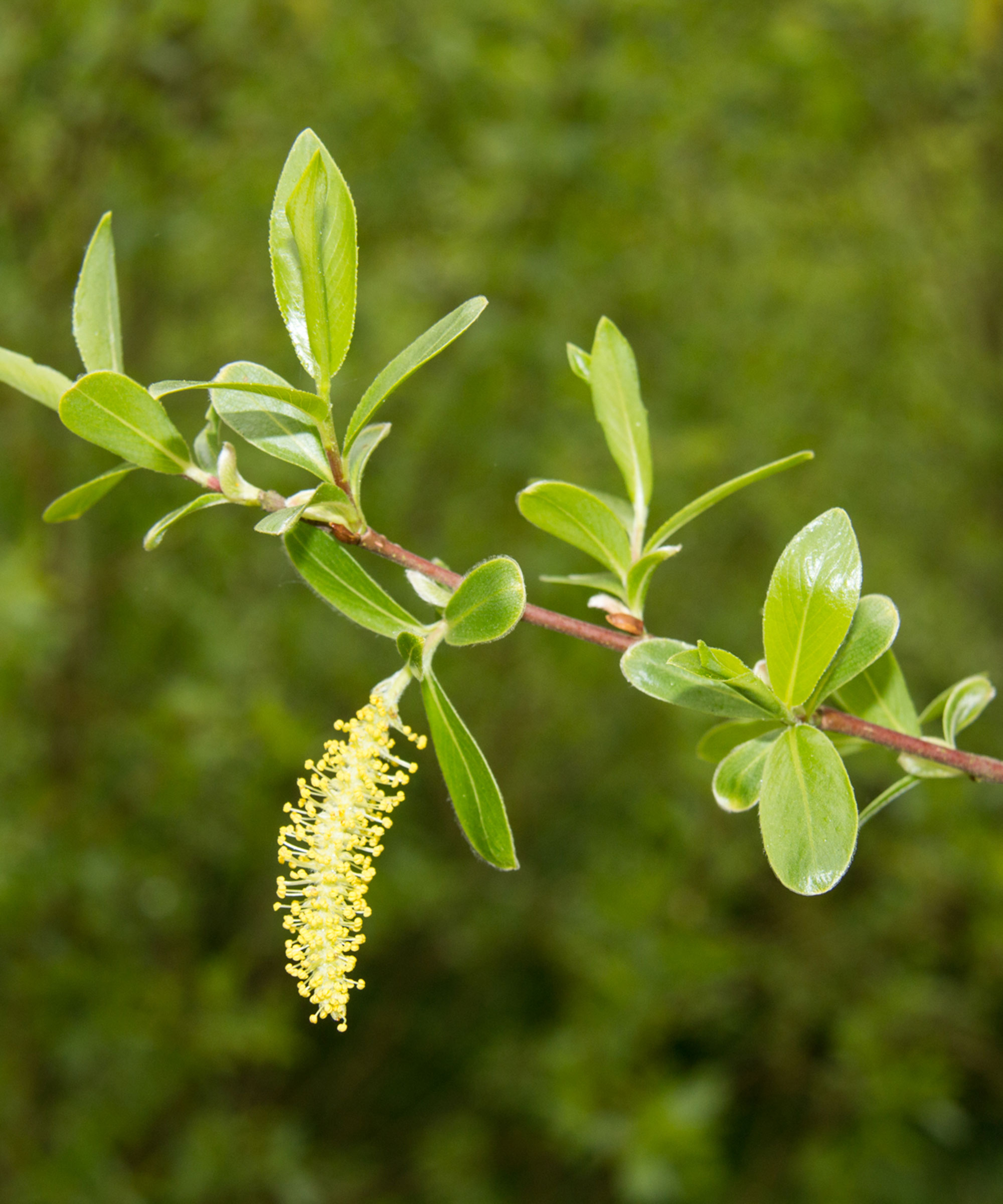
The leaves are lanceolate, tapering at both ends, and are up to 10cm long and 1.25cm wide. The fruit is a green capsule, ripening to release numerous white-haired seeds, which are dispersed by the wind. Male catkins are 5cm long and have yellow anthers; female catkins are green and smaller.
Photography / The Woodland Trust
Folklore fact: Those suffering from aches or pains – or hangovers – were often advised to eat willow bark. This is not as strange as it seems for bark of white willow contains, Salix alba, which contains salicylic acid - a natural pain-reliever and component of the drug aspirin.
6. Oriental Spruce
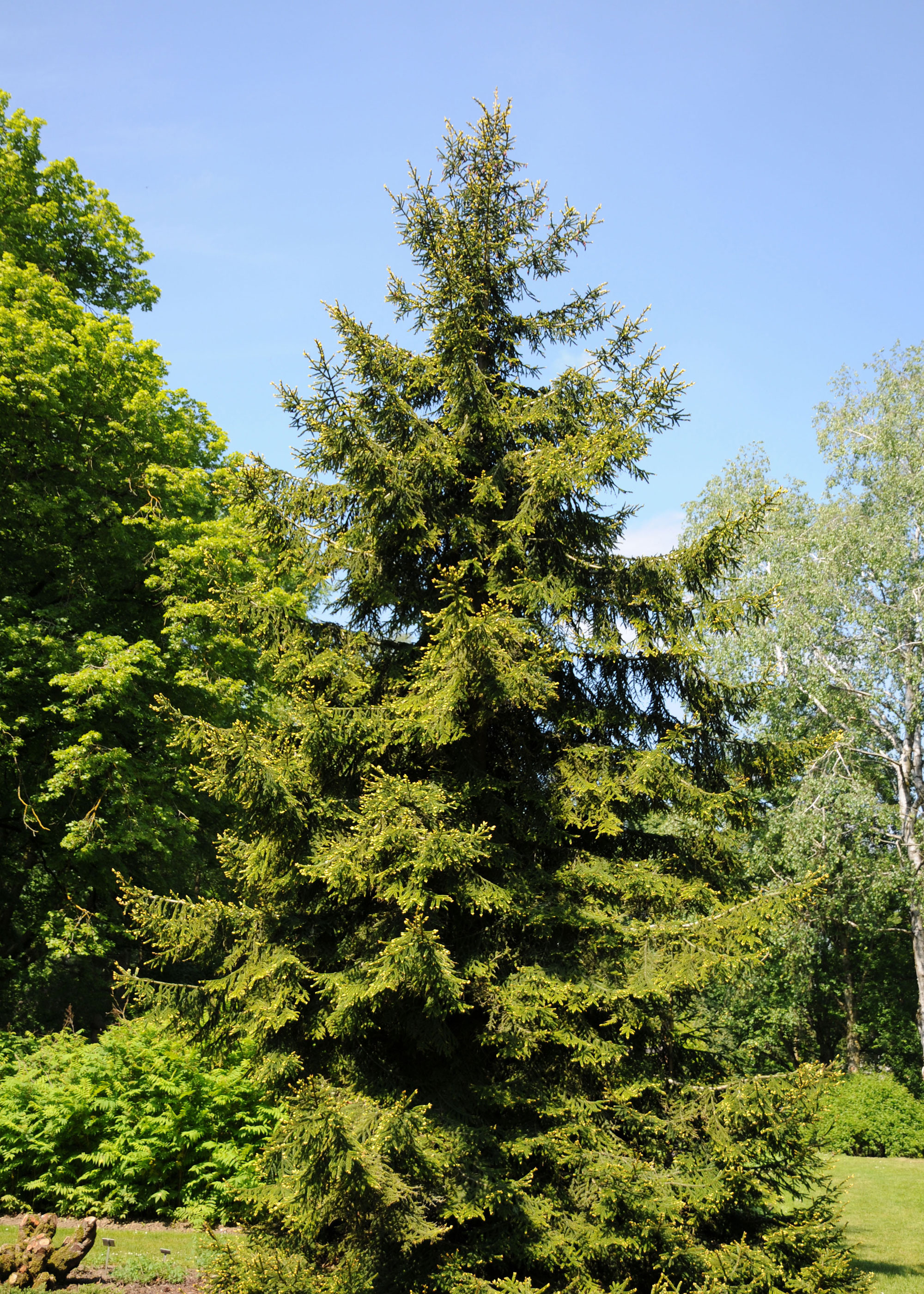
Oriental Spruce Caucasian spruce Picea orientalis bark is pinkish- brown, relatively smooth at first, flaking into small irregular plates in maturity. The needle-like leaves are up to 1cm long, bluntly pointed at the tips, shiny dark green above, paler beneath and pointing forward on buff-coloured shoots.
The fruit is a cylindrical drooping cone, up to 10cm long, purple ripening to brown, and covered with patches of sticky aromatic resin.
Photography / Paramount Plants
7. Yulan Magnolia
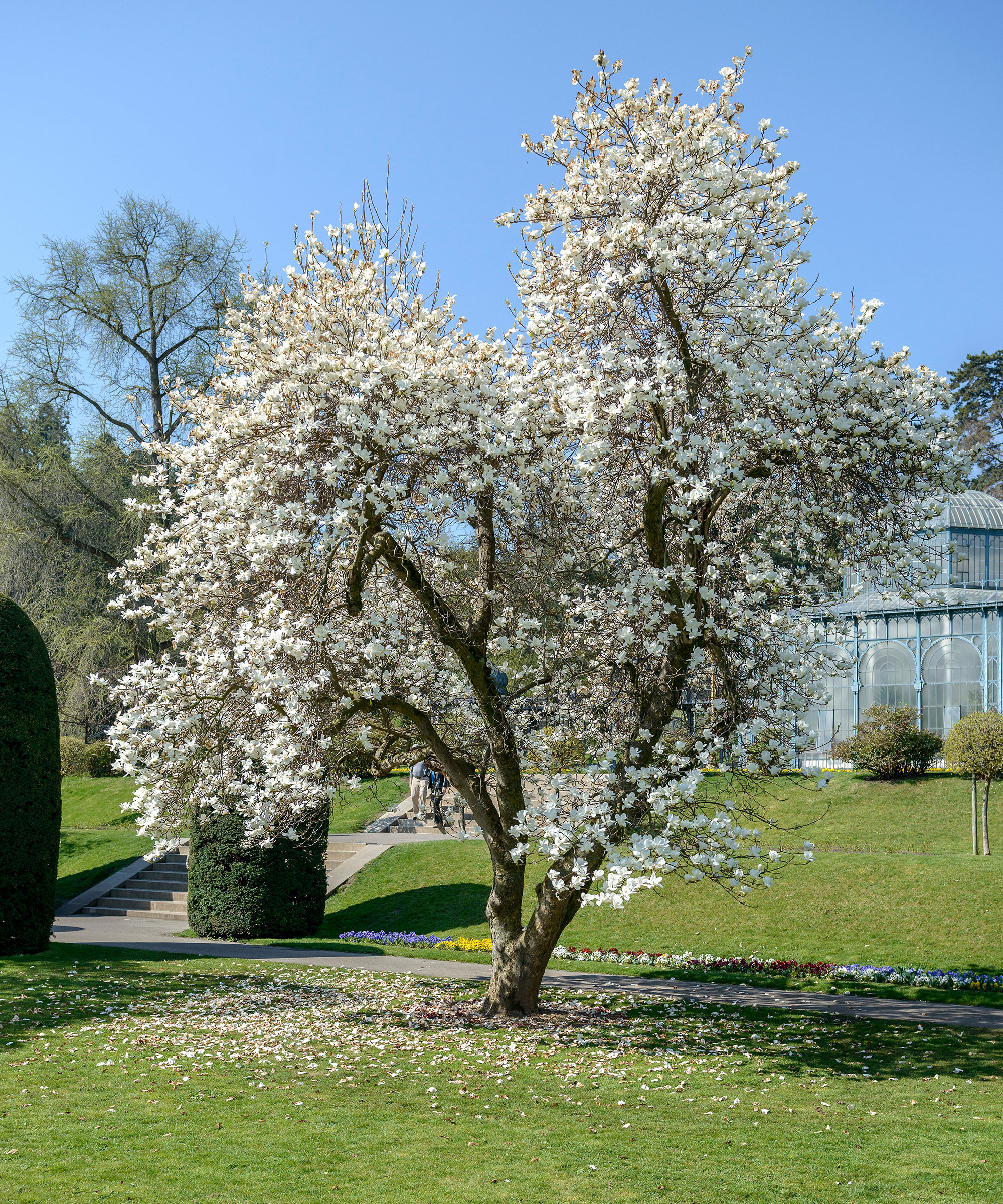
Yulan magnolia Lily tree Magnolia denudata is a rather low, rounded, thickly branched tree. It has thick, bright green leaves that are ovate, 15cm long and 7.5cm wide. After falling they decompose to leave a skeletal form.
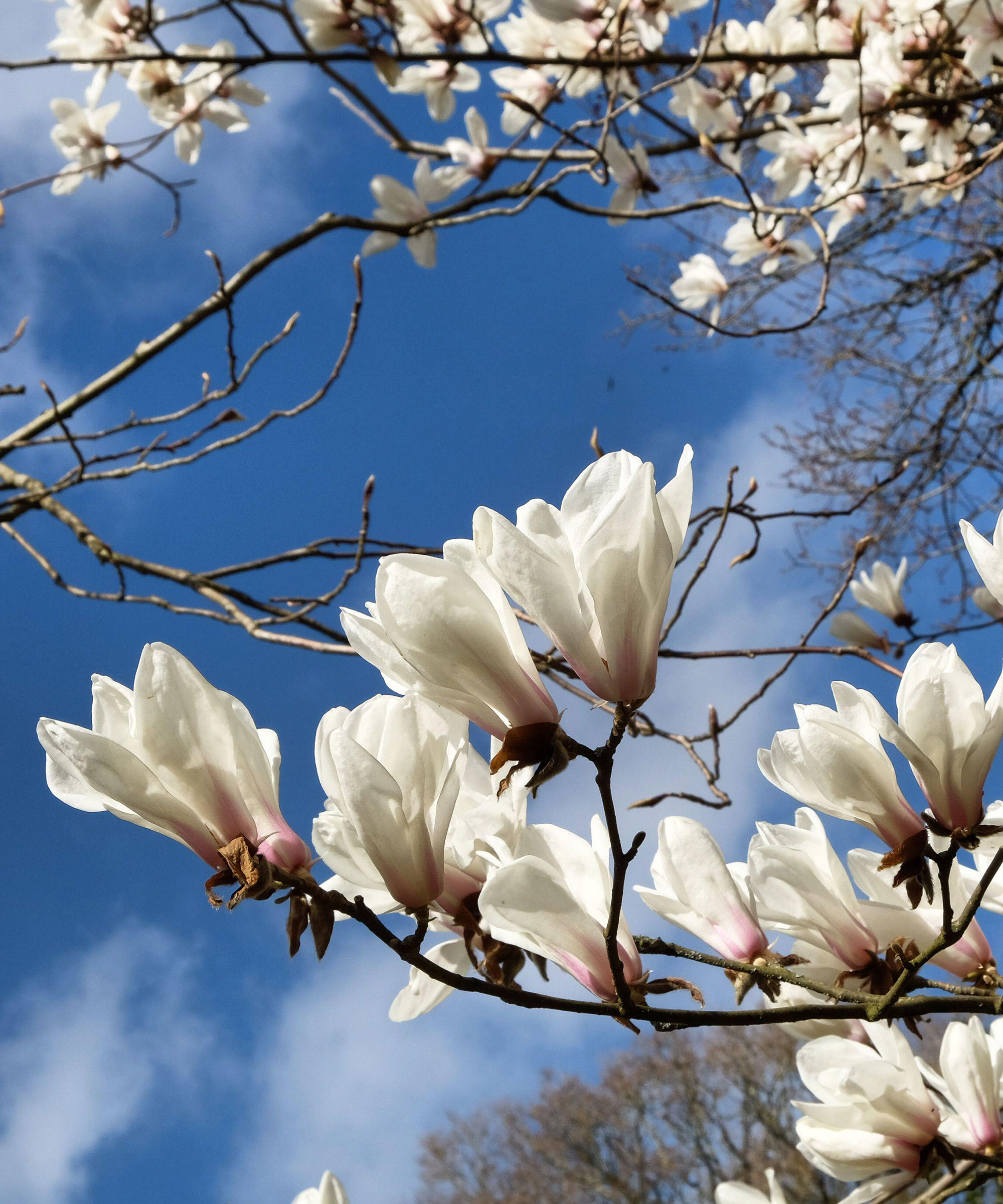
The beautiful pure white flowers are heavily scented with a citrus-lemon fragrance. They open from early to late spring: erect and goblet- shaped at first, then they gradually spread to form a water-lily shape, as each thick petal curls outwards.
Photography / Alamy
8. Bay Laurel
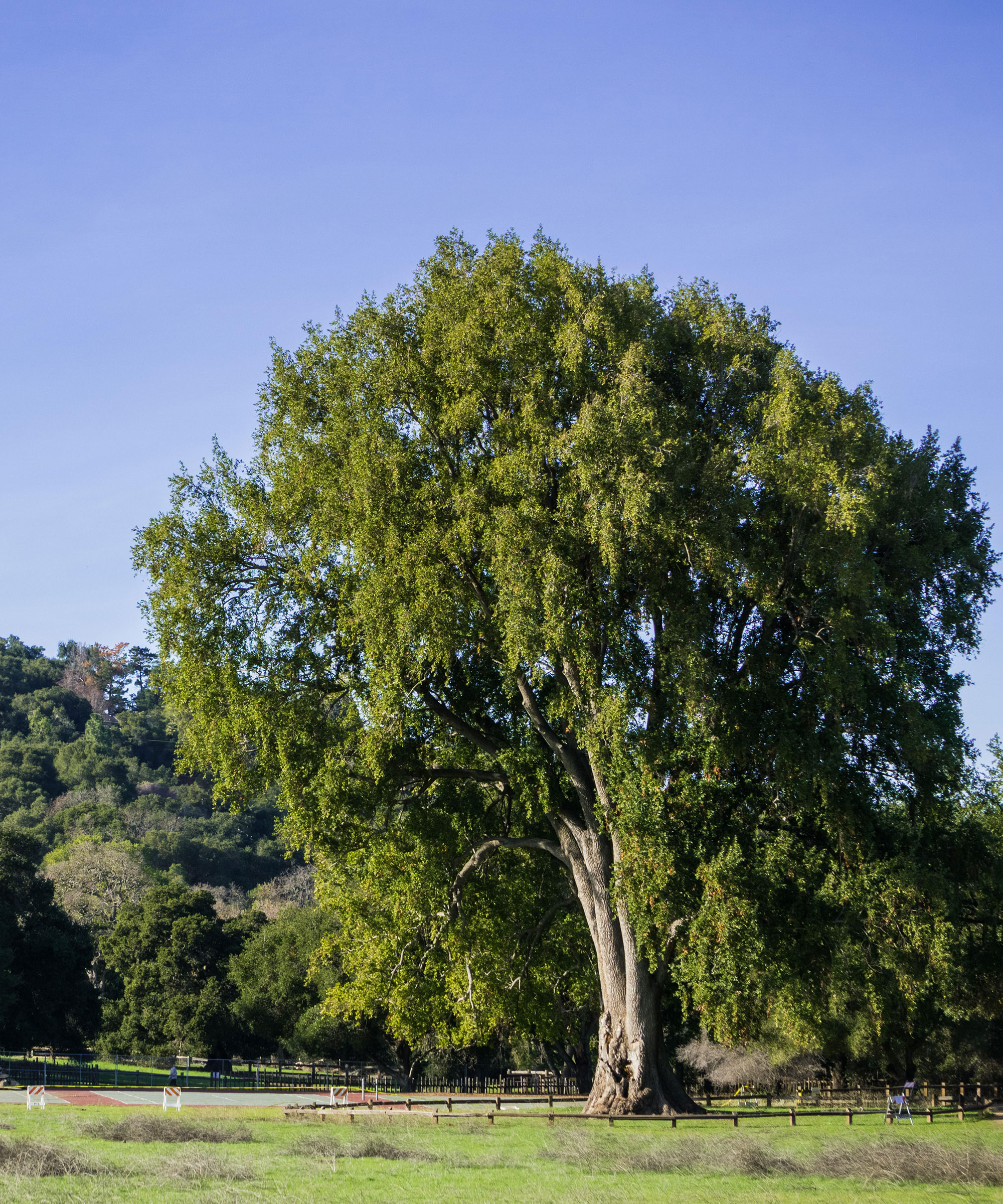
Bay Laurel Sweet bay Laurus nobilis is the laurel used by the Greeks and Romans as a ceremonial symbol of victory. A dense small tree or shrub with aromatic leaves, which are widely used to flavour food. The bark is dark grey and smooth, even in old age.
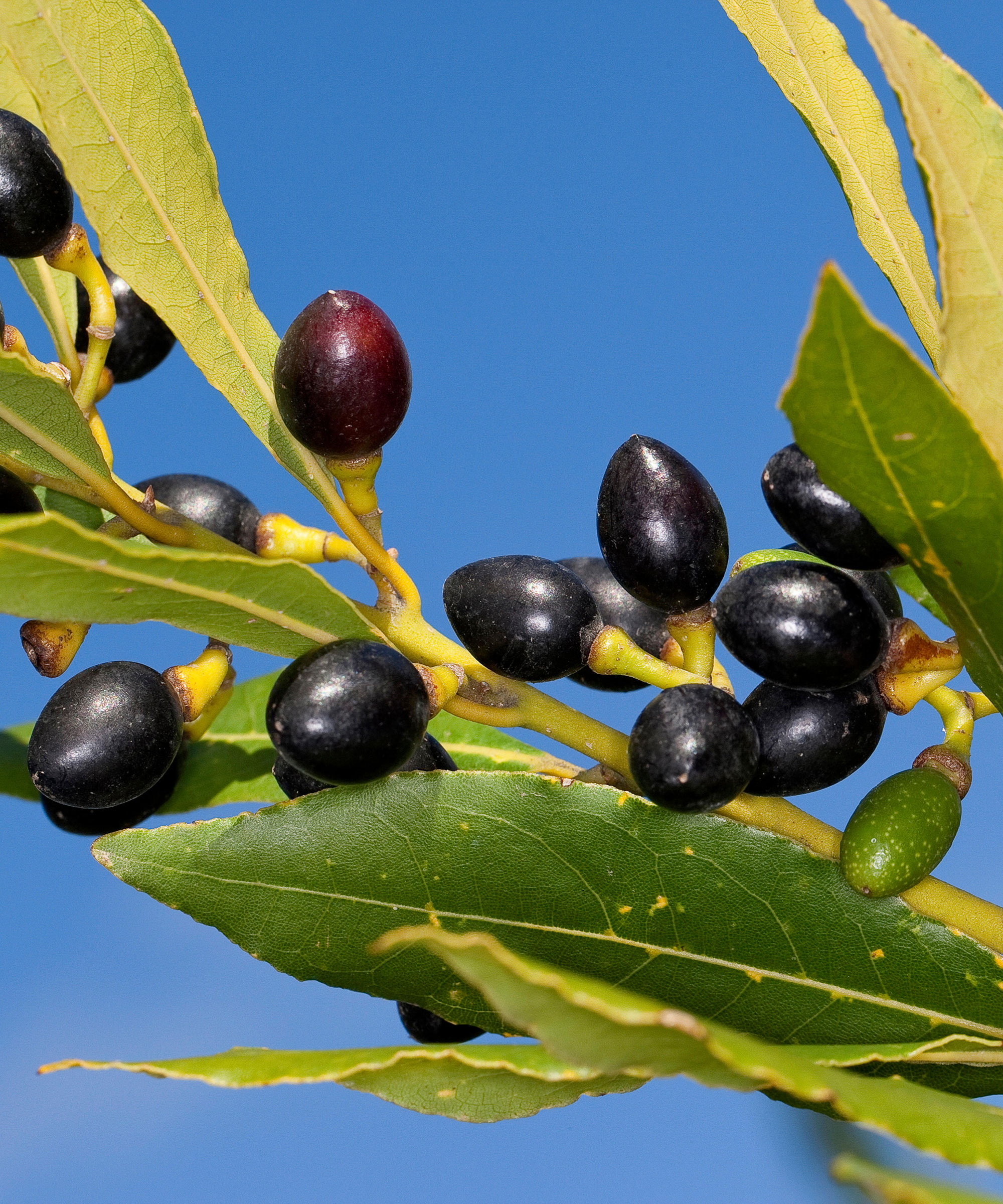
The leathery, glossy leaves are alternate, dark green above with a central lighter vein, and pale green beneath. They are 10cm long, 4cm across and pointed at the tip. The male flowers, which appear in late winter, are greenish-yellow, 1cm across, with many yellow stamens, positioned in the axils of the previous year’s leaves.
The fruit is a rounded berry, 1cm across, green ripening to glossy black.
9. Common Olive
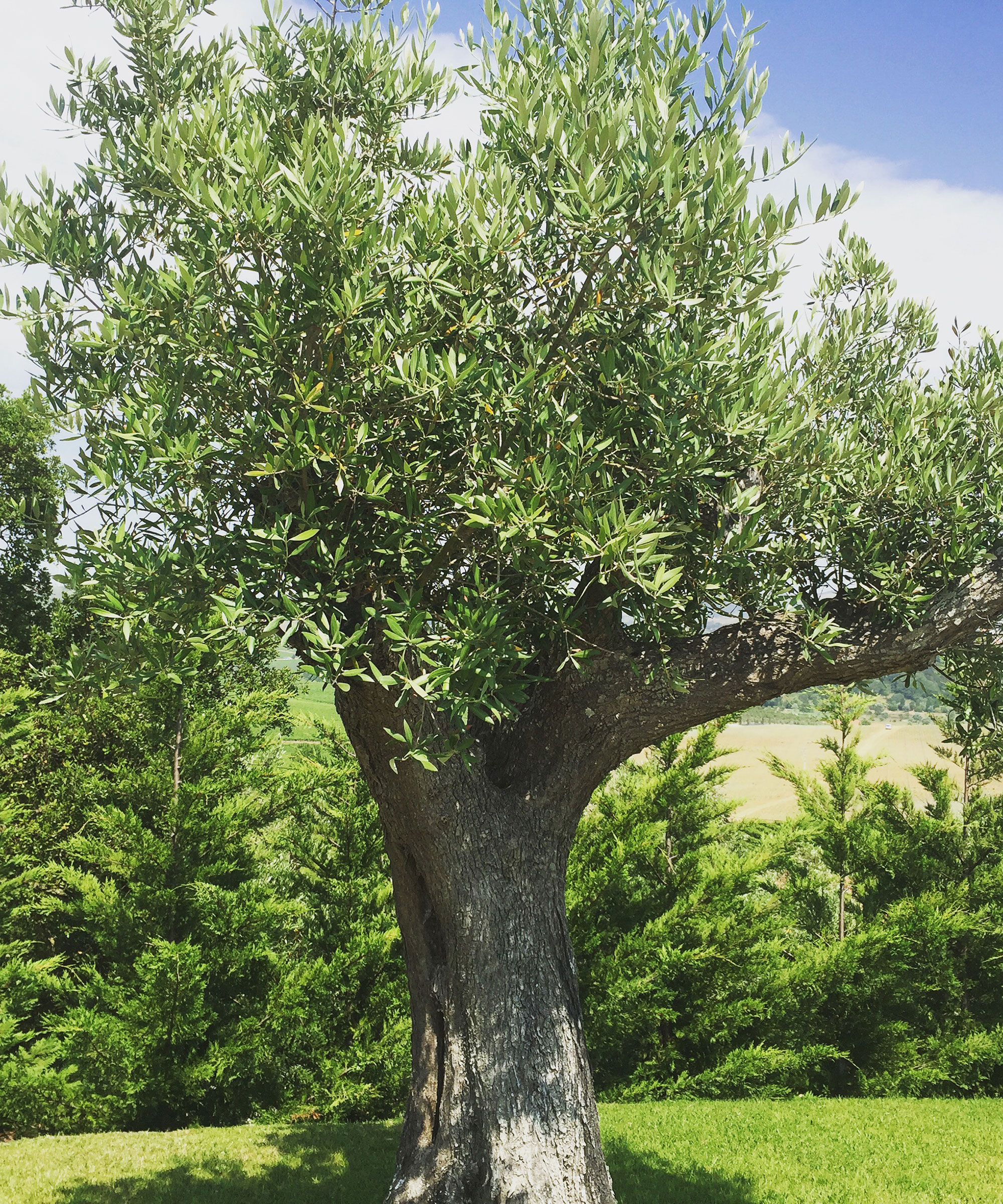
Common Olive Olea europaea has been cultivated for its fruits and oil in the warm regions of Europe for thousands of years, to the extent that its true native distribution is now obscure. It has a distinctive, short grey, fissured trunk, which may become very thick and hollow in maturity, and a broadly spreading crown. Small racemes of fragrant white cruciform flowers are produced in late summer.
The green oval fruits, each containing a single seed or stone, ripen to a glossy purple-black. The grey-green, tough, leathery, evergreen leaves, which are silver-sage beneath are an instant guide to identification.
Photography / Paramount Plants
10. Caucasian Wing Nut
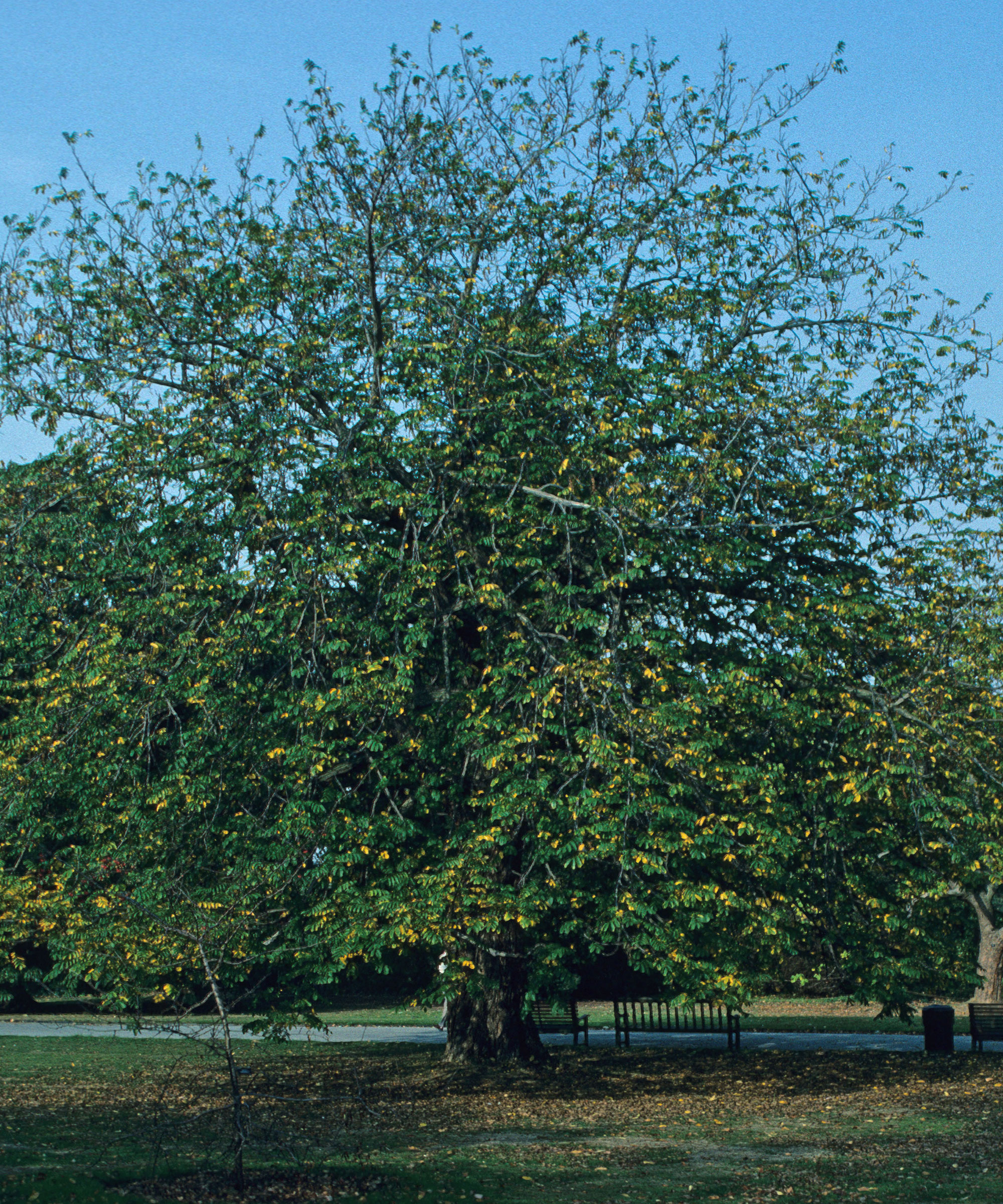
Caucasian Wing Nut Pterocarya fraxinifolia is a very fast- growing species, quite regularly achieving 3m of growth in a single year. The bark is light grey, smooth in young trees and becoming fissured in maturity.
Photography / Alamy by David Hosking
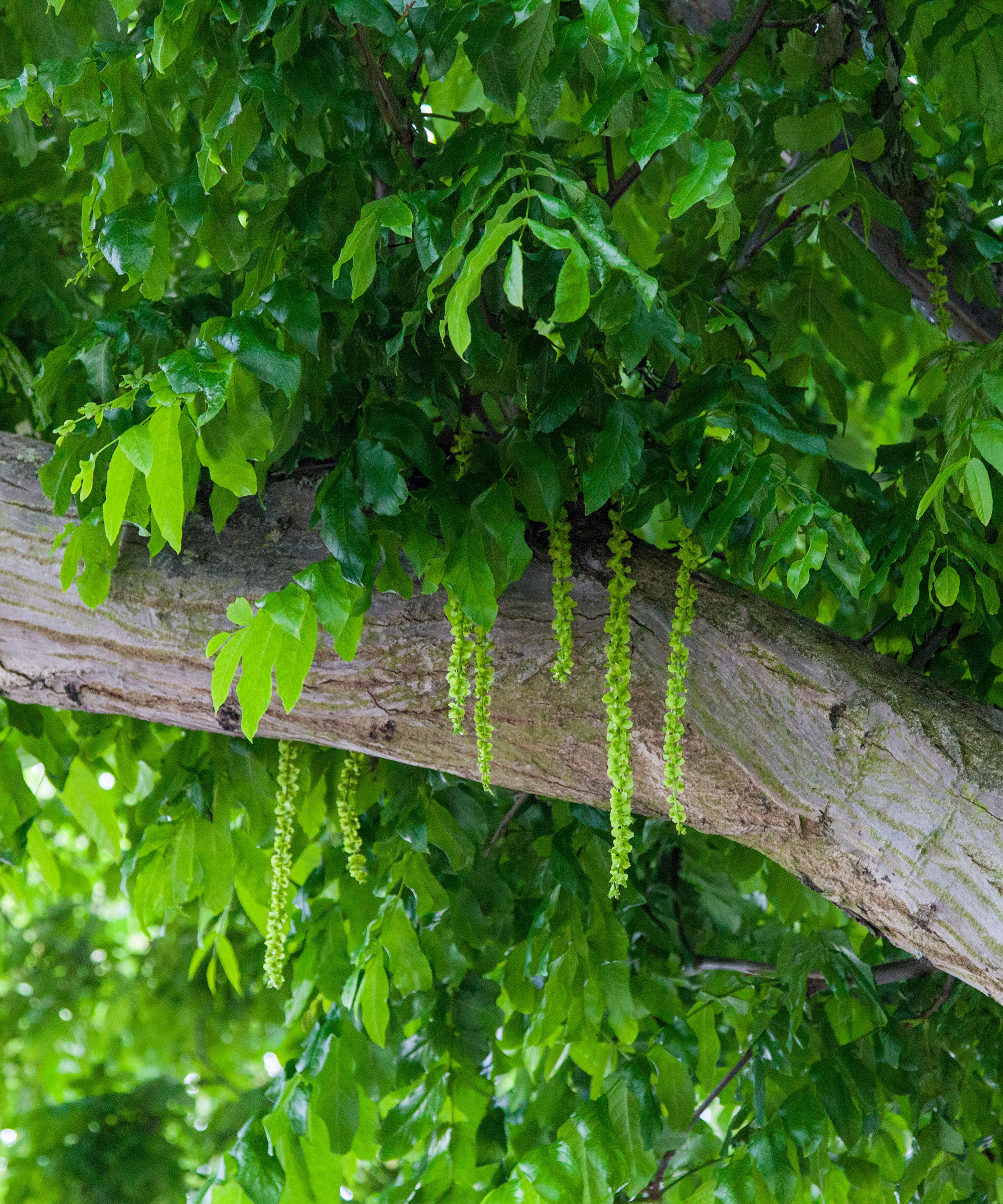
The leaves are pinnate, up to 60cm long and made of up to 23 slightly toothed, ovate to oblong dark green leaflets, up to 15cm long. Winter buds are naked, with brown hairy bud leaves.
The small flowers, green with a red stigma, are carried in pendulous catkins up to 15cm long in spring. The nuts are borne in hanging “necklaces” up to 50cm long. The flowers hang in pendulous catkins. The nut-like fruit has a pair of semicircular wings.
Photography / Alamy by Paul Wood
11. Common Beech
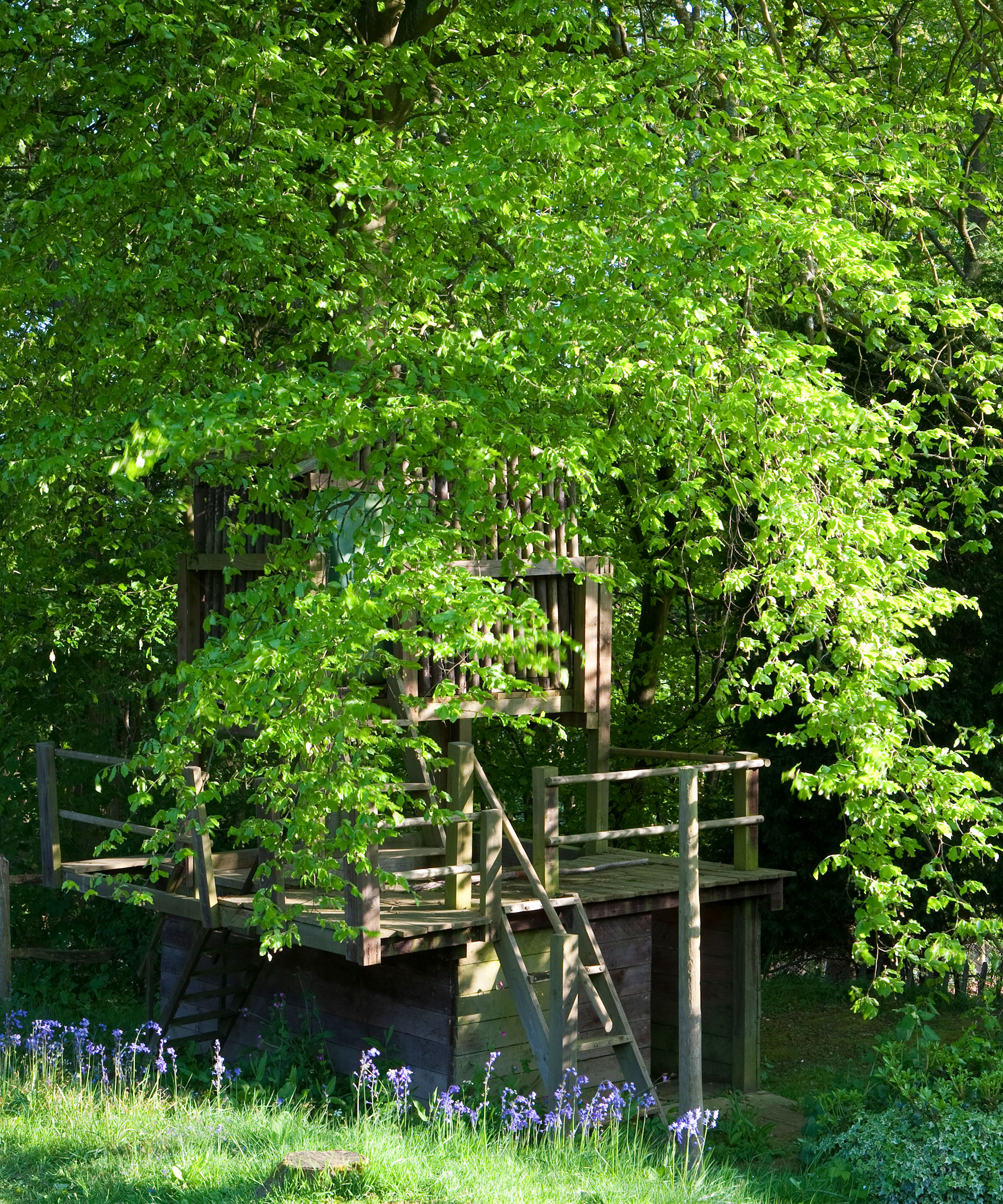
Common Beech European beech Fagus sylvatica bark is silver-grey and remains smooth in maturity. Beech flowers are small: the female flowers are green and the males yellow, and they are borne in separate clusters on the same tree in spring.
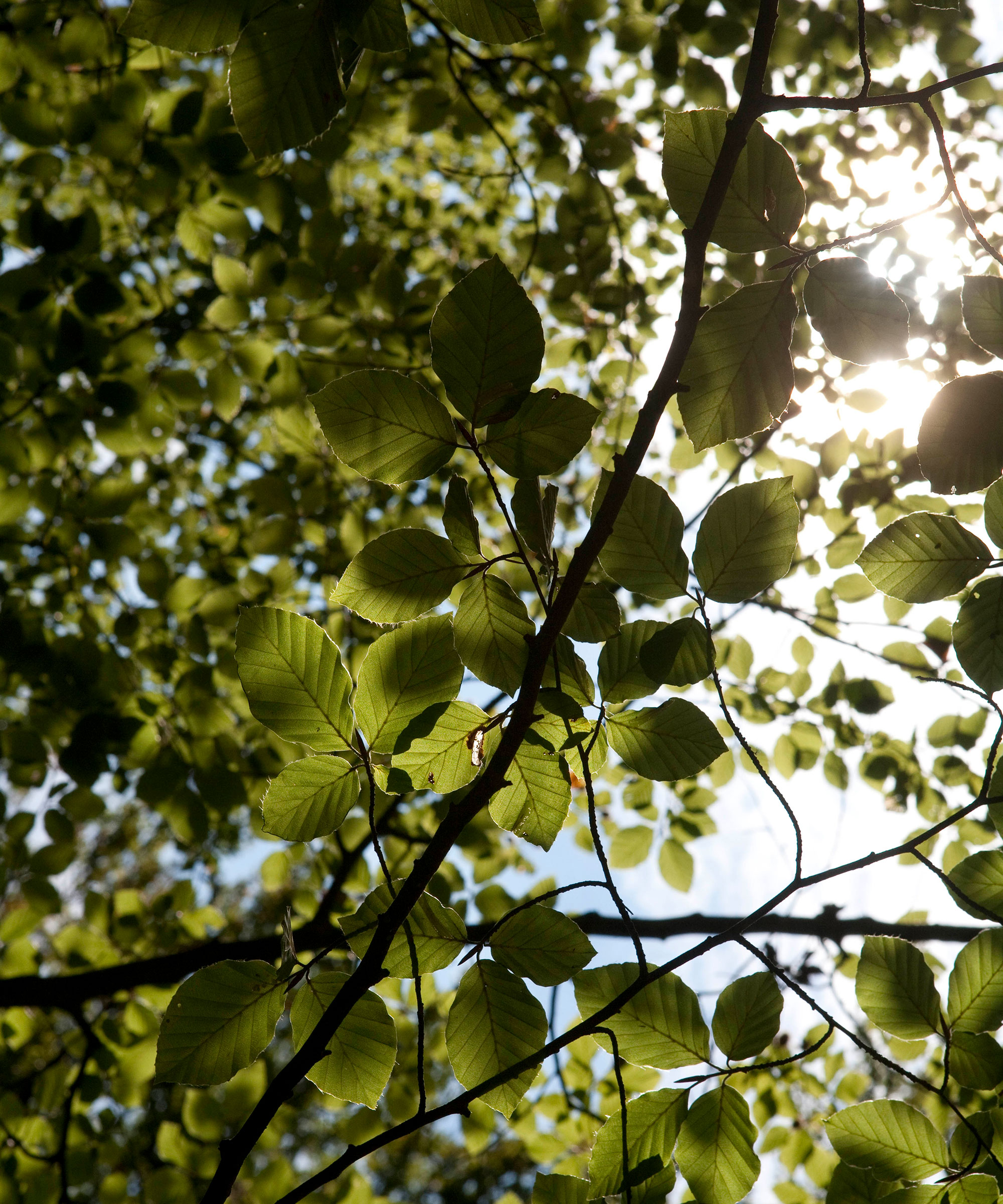
The fruit is an edible nut. Up to three nuts are contained within a woody husk, which is covered in coarse bristles. The husks open in early autumn. The leaves are up to 10cm long and 5cm wide. They have a wavy, but normally untoothed, margin and a rather blunt point at the tip.
In spring, juvenile leaves have a covering of hairs and are edible, with a nutty flavour. As they mature, the leaves become tough and bitter with a smooth finish and rich colour.
12. Sweet Chestnut

Sweet Chestnut Spanish chestnut Castanea sativa is a fast-growing ornamental tree native to warm, temperate regions around the Mediterranean and in south-western Asia. As a young tree the bark is smooth and grey. Older trees develop spiral fissures, which immediately distinguish the tree from oak.
Photography / Chris Walters for the Woodland Trust
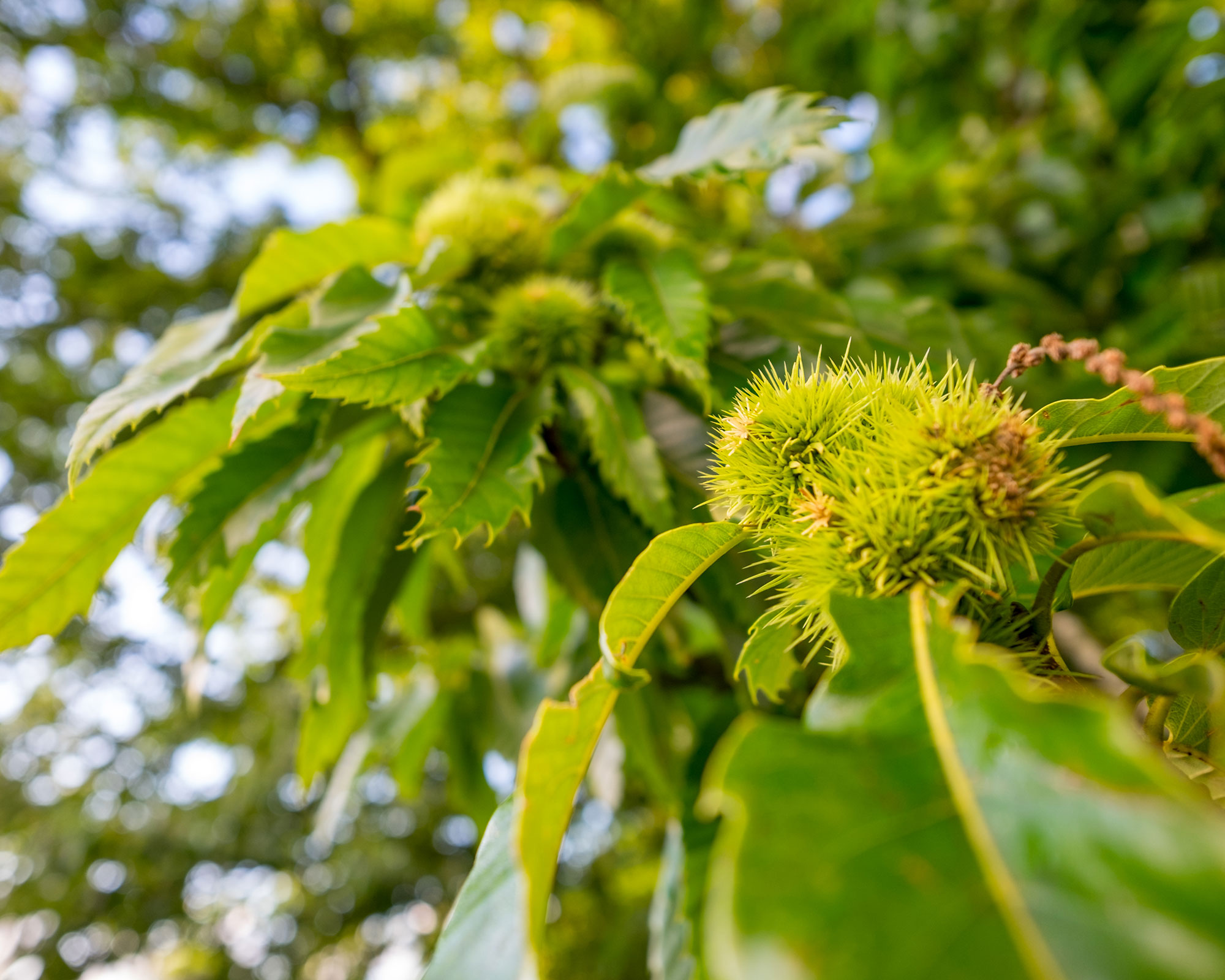
The leaves are oblong, up to 20cm long, sharply pointed at the tip and rounded at the base. The leaf margin is edged with coarse teeth, each tooth linking to a strong vein running back to the midrib.
The male and female flowers are borne on the same upright yellow catkin in summer, making it one of the last trees to come into flower. Each catkin may be up to 25cm long. The fruit is a spiny greenish-yellow husk, up to 6cm across, with up to three edible brown nuts.
13. Silver Birch
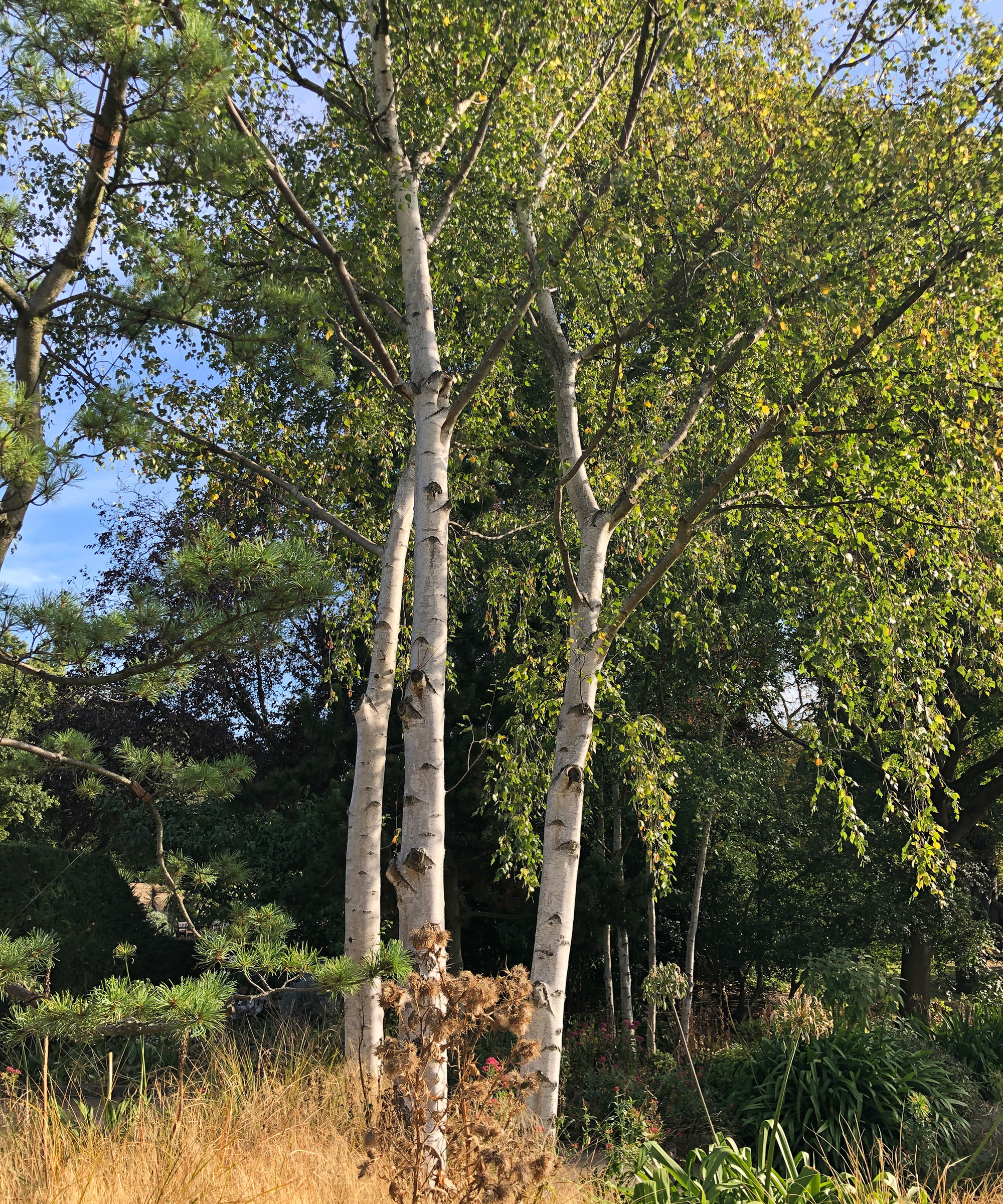
Silver Birch Betula pendula is often planted for the ornamental value of its distinctive bark which is a white to silver colour. Mature trees develop corky black fissures between white irregular plates.
Photography / Paramount Plants
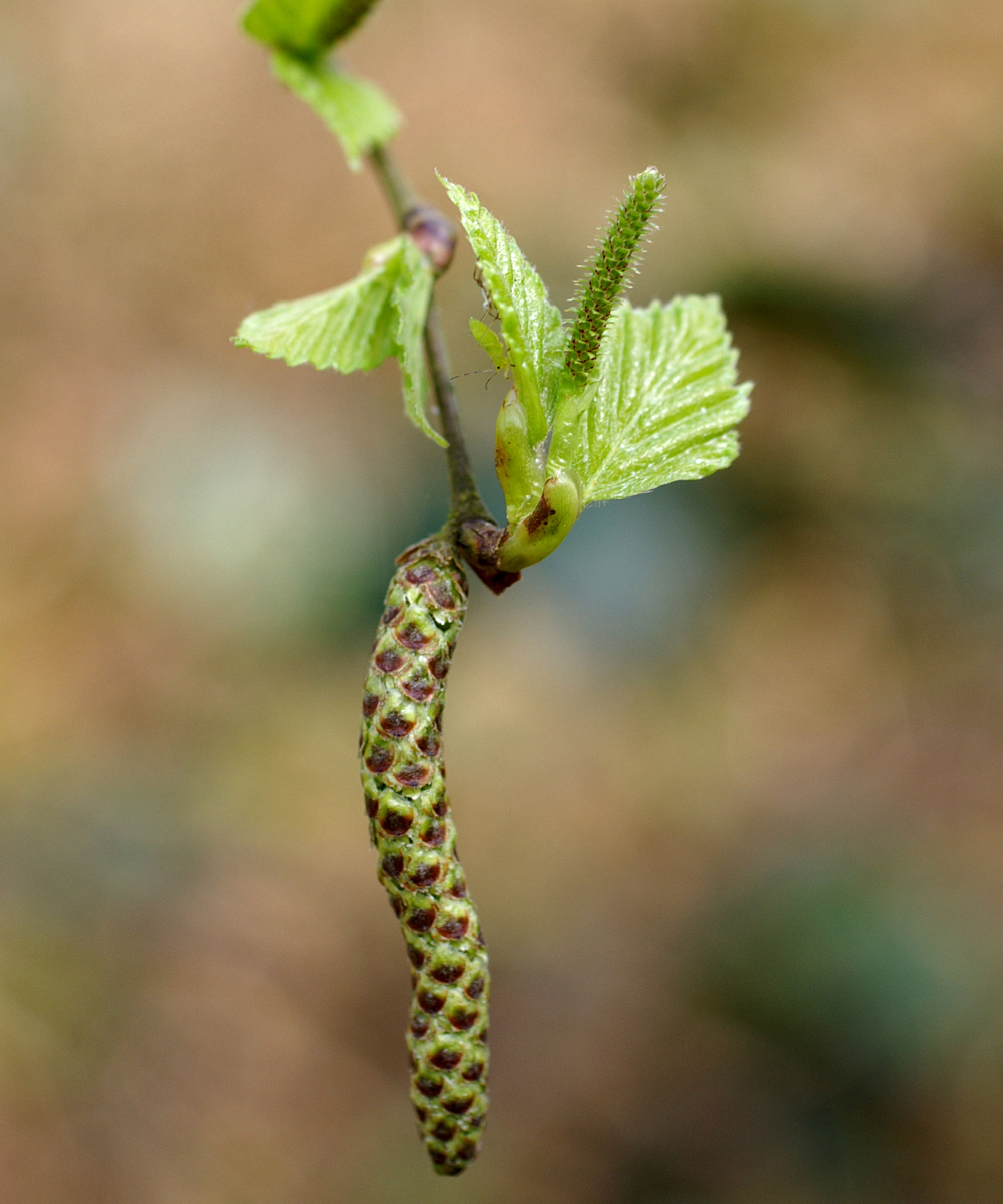
The leaves are almost triangular in shape, 6cm long and 4cm across, tapering to a point. They are glossy grass green above and paler beneath, normally turning butter yellow before falling in autumn.
The leaf stalk is usually red-brown, 2.5cm long and attached to a slim, hairless, warty, weeping shoot. Both male and female flowers are catkins, appearing separately on the same tree in early spring. The male flower is yellow and drooping, up to 6cm long; the female flower is green, erect and smaller.
Photography / Woodland Trust
14. Wild Cherry
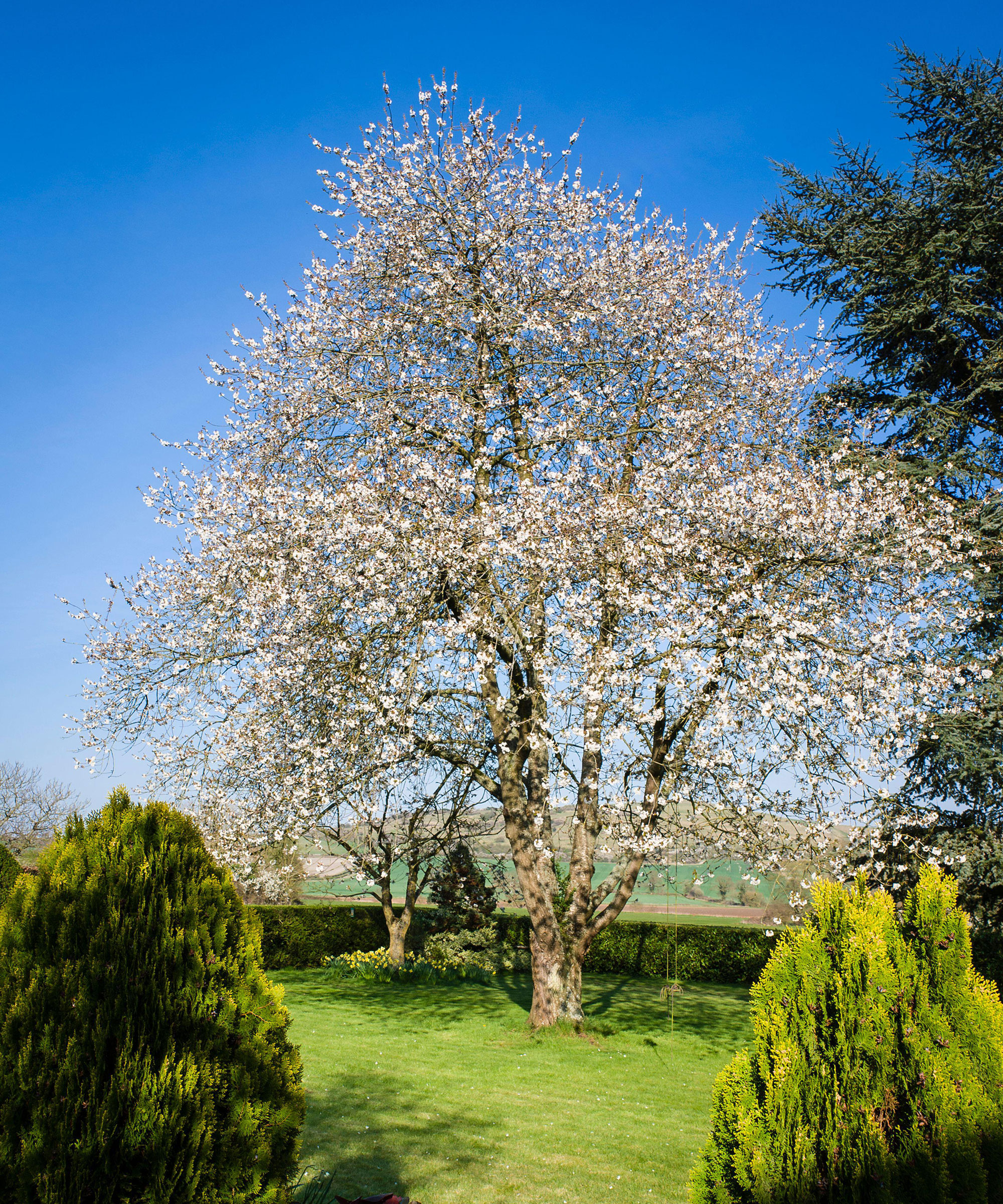
Wild Cherry, Gean, Mazzard Prunus avium is the largest of Europe’s native cherries. The botanical name avium, meaning “of the birds”, is a reference to the fact that the fruit is loved by birds.
The bark is rich red brown and glossy; in maturity distinctive horizontal light brown bands of lenticels, interspersed with peeling red-brown bark, ring the stem. Suckering around the base is common.
The leaves are elliptic, occasionally oblong, up to 15cm long and 5cm broad, deep green on both sides and sharply toothed around the margin. The fruit of the wild cherry is small and shiny and may taste sweet or bitter.

The sweetly scented flowers are single, white with five petals, 2.5cm across and borne in clusters in spring just as the leaves emerge from bud.
Photography / Trees Direct
15. Midland Hawthorn
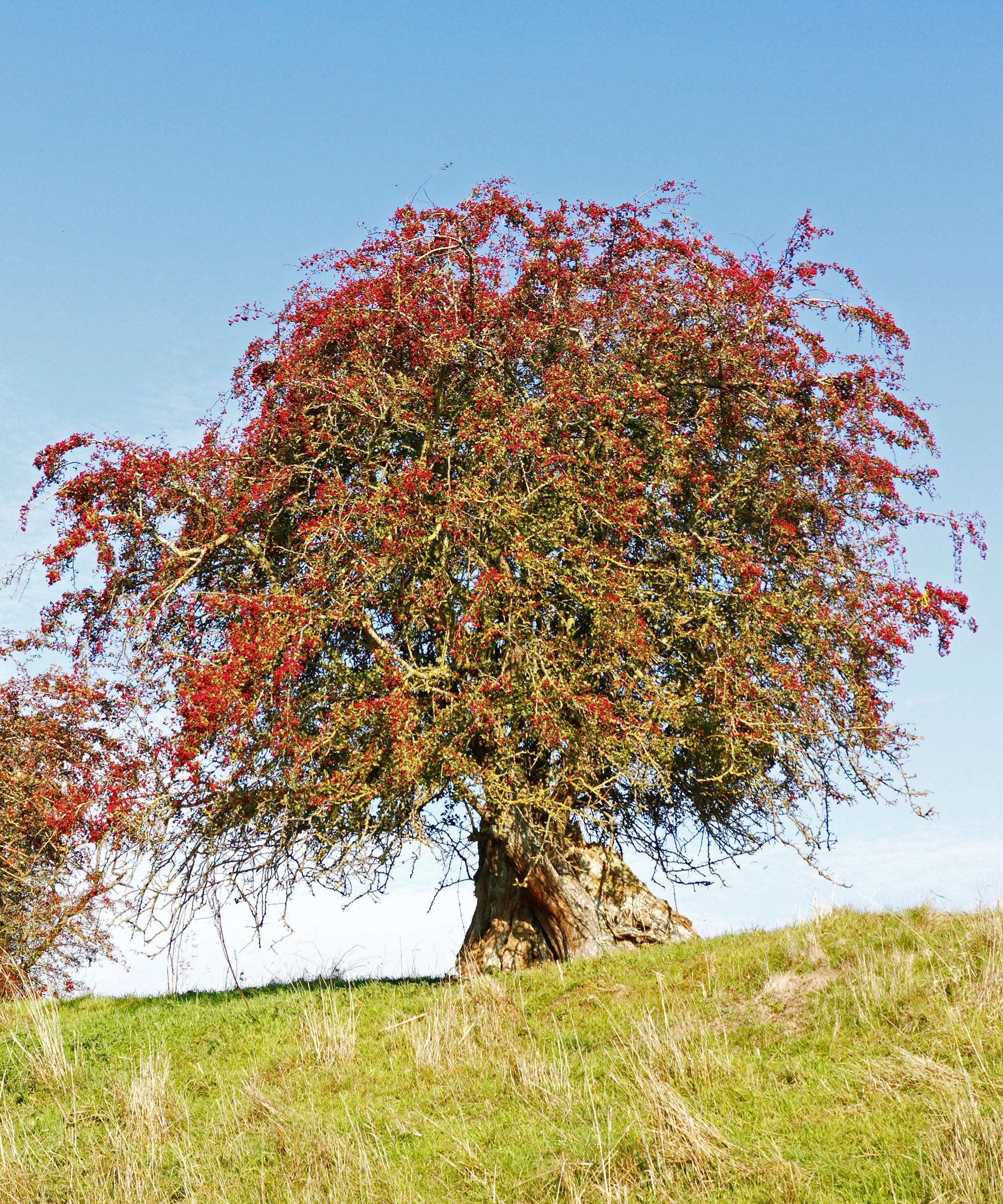
Midland Hawthorn Crataegus laevigata is a hardy small tree taking its name from an area in central England, where it is found growing in much profusion and is an accepted indicator of sites of ancient woodland.
The bark is grey-brown, smooth at first becoming cracked into small plates in maturity.

The leaves are glossy dark green above, paler beneath, shallowly lobed and toothed, up to 5cm across and long. The flowers are scented, white with five petals and pink-orange anthers, and occur in small clusters in late spring and early summer.
They are followed by oval, glossy red fruits (haws),up to 2.5cm long, each containing two hard seeds.
16. English Yew
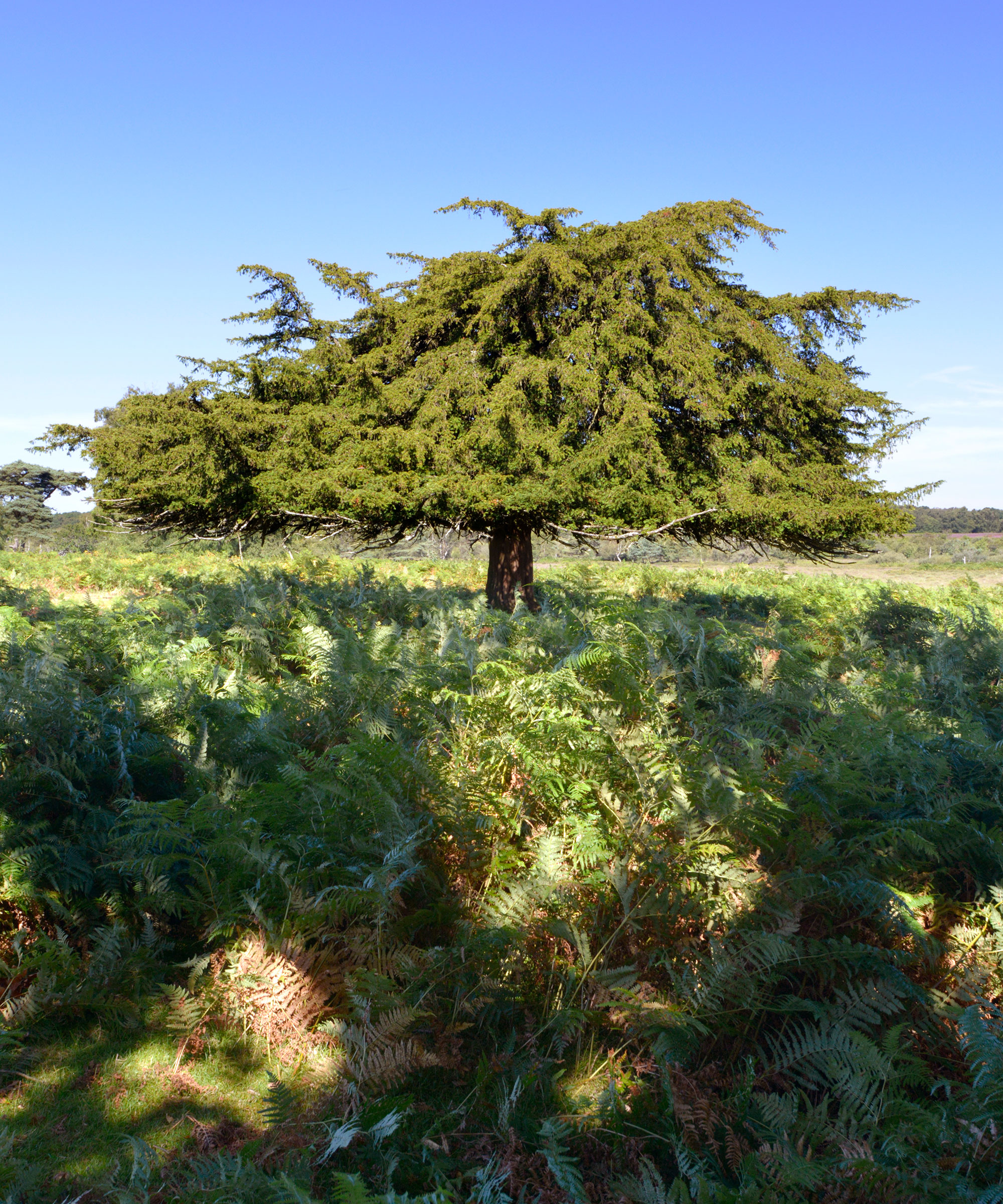
English Yew Common yew Taxus baccata develops a very dense, evergreen canopy, which gives this tree a sombre feel that is heightened by its long association with burial grounds and churchyards.

The leaves are glossy above with a central groove and the bark is rich brown with a purple hue. The male cones shed pollen with cloud- like abundance in spring. The fruit is fleshy, turning red at maturity, around an olive-green seed.
Photography / Woodland Trust
17. Crab Apple

Crab Apple Malus sylvestris is known to many as the “sour little apple”, because of its profusion of small, green, inedible apples in late summer.
The overall appearance is of an uneven, low-domed tree with a head of dense twisting branches, normally weighted to one side. The bark is brown and fissured, even when the tree is relatively young.
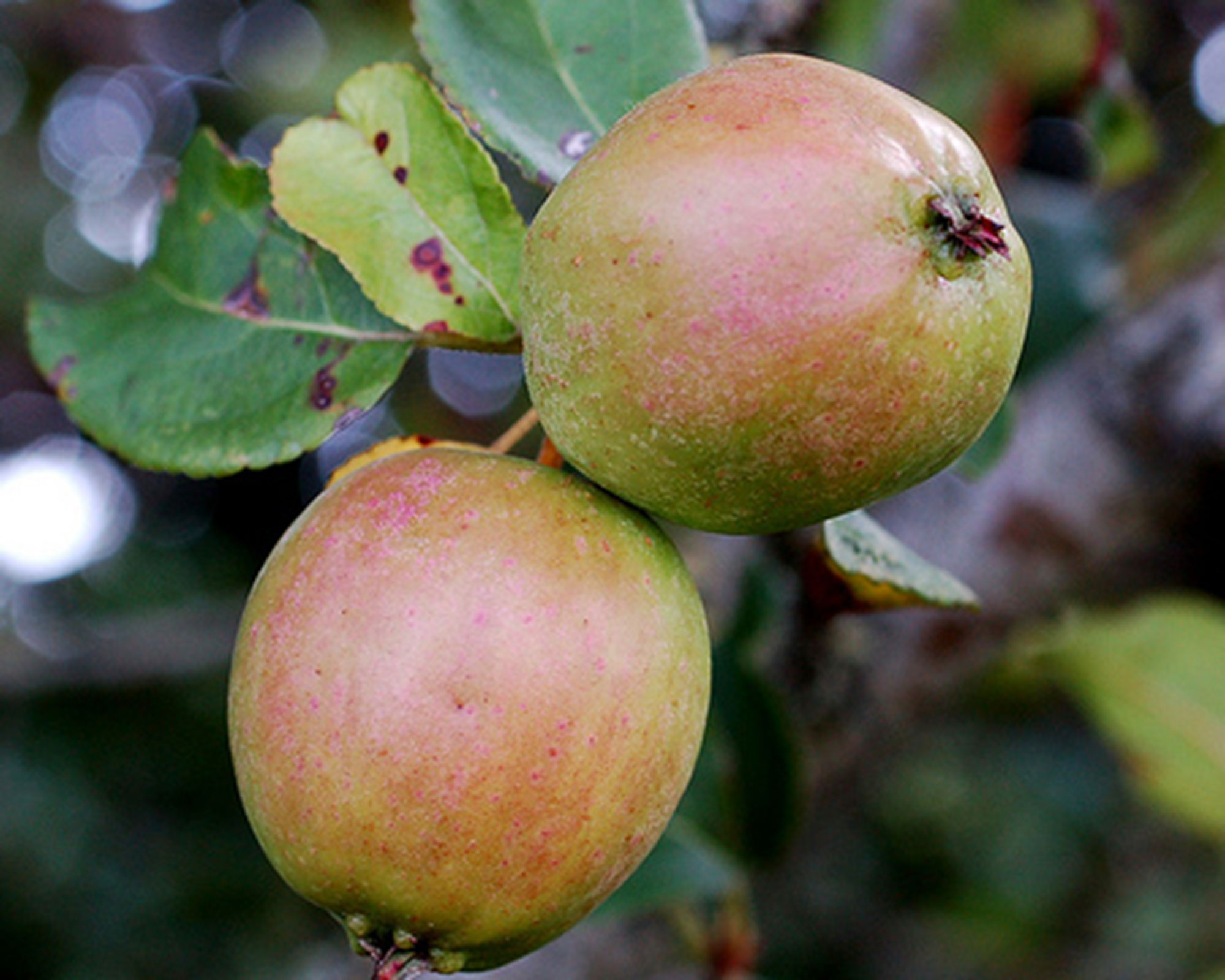
The leaves are elliptic to ovate, 4cm long, slightly rounded at the base, deep green above and grey-green beneath with some hair on the leaf veins. The leaf margin is finely, but bluntly, toothed.
The flowers are white, flushed with pink, 2.5cm across and carried on short spurs. The fruit is apple-like, up to 4cm across, green to yellow and sometimes flushed with red.
Photography / Trees Direct
18. Common Pear
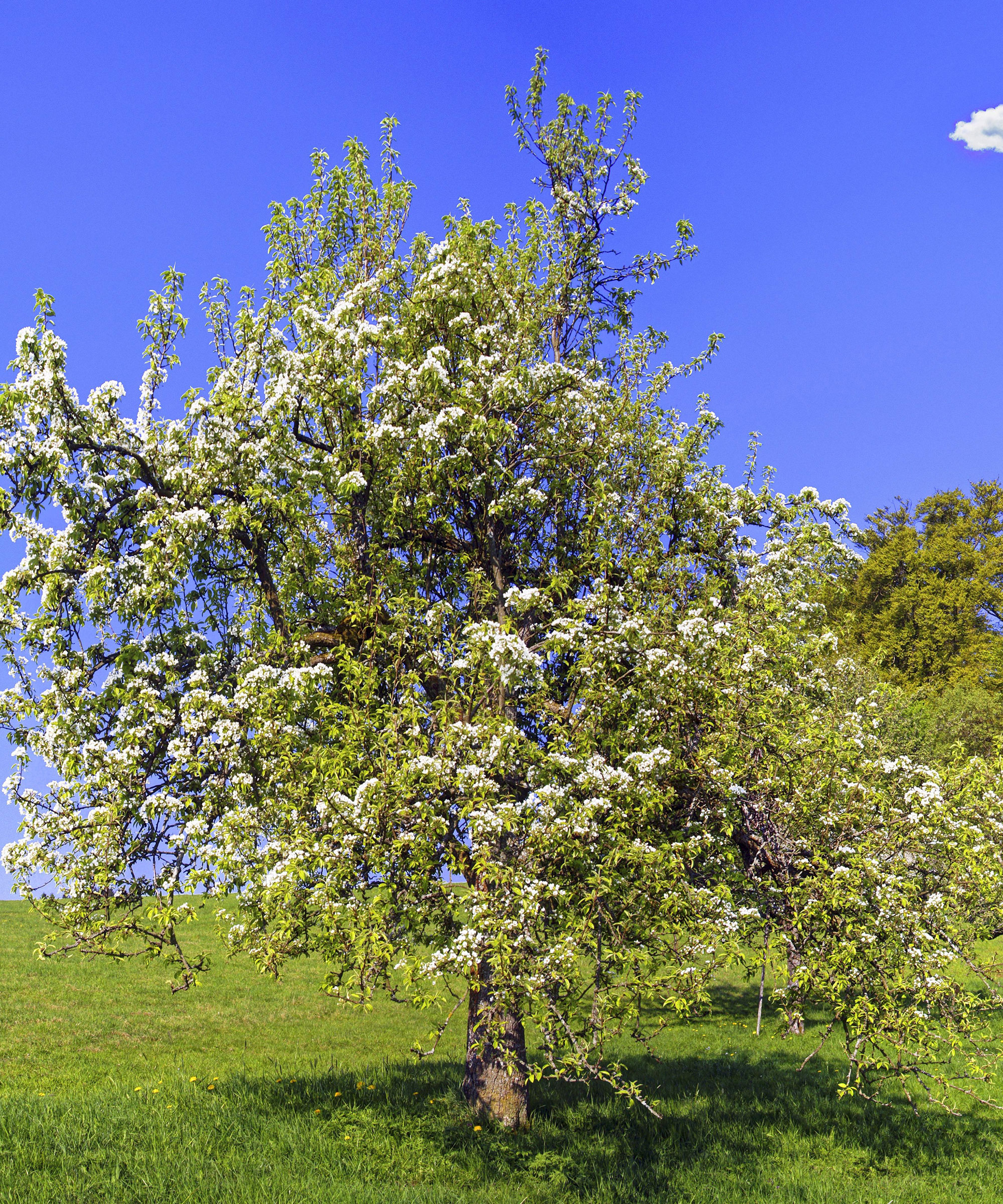
Common Pear Pyrus communis has a tall columnar to pyramidal crown and distinctive spur shoots (rarely spines) which give the tree a slightly angular appearance. The bark is dark grey, cracking into small irregular flakes in maturity.
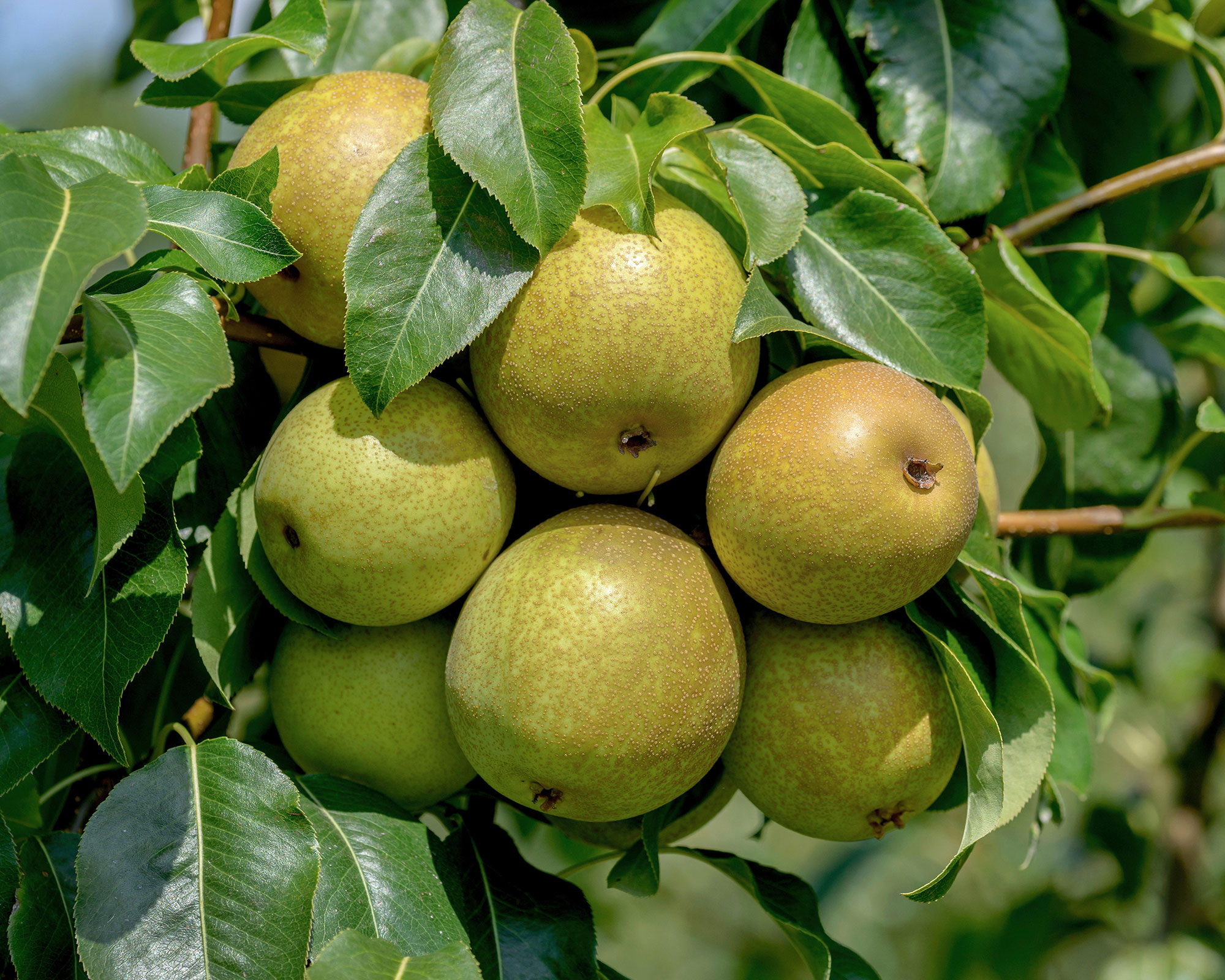
The leaves are a glossy dark but bright green, mainly rounded at the base and up to 10cm long and 5cm across.
The flowers are single white, with five petals and purple anthers, borne in clusters in mid-spring. The fruits are variable, rounded to pear-shaped, containing sweet, edible flesh surrounding small, hard, brown seeds.
Photography / Alamy

Jennifer is the Digital Editor at Homes & Gardens, bringing years of interiors experience across the US and UK. She has worked with leading publications, blending expertise in PR, marketing, social media, commercial strategy, and e-commerce. Jennifer has covered every corner of the home – curating projects from top interior designers, sourcing celebrity properties, reviewing appliances, and delivering timely news. Now, she channels her digital skills into shaping the world’s leading interiors website.